|
Music Life Magazine, Japan

1974 - Photos by
Terry O'Neill / Michael Putland
1974 January 17, POP
Magazine No. 2
- Alvin Lee's Guitar, Photo taken
in spring 1973 -

Contribution by Marcel
Aeby
|
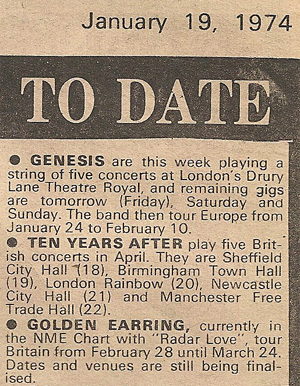
New Musical Express - January
19, 1974
|
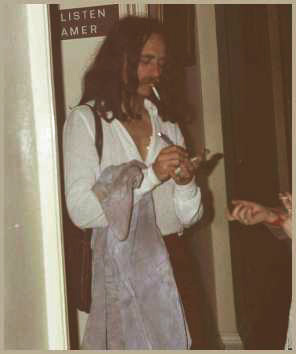
Photo by Pieter Kentrop |
|
Beat Instrumental – January 1974
Alvin Lee On The
Road To Freedom!
Old “Speed
Fingers” himself talks about a new friend and a new
direction:
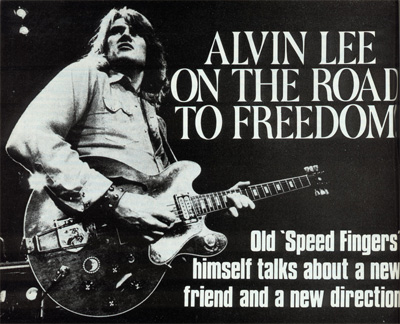
Almost ten years
later, Ten Years After have proved their point in both
name and deed, but Alvin Lee, guitarist, song-writer and
front-man with the band, has recently brought out an album
which shows his interest and ability in other musical
fields, and one which moves right away from his
“Speed-Fingers” image. Ten Years After have been together
since 1967, playing their own brand of rock `n´ roll and
jazz-influenced numbers in a stormy act that has been to
the States 18 times, and most other countries in the
world.
His new album, “On
The Road To Freedom,” consists of country, blues gospel
and rock-flavoured songs written mainly by Alvin and his
friend Mylon LeFevre. Mylon is a guitar-picker and singer
from Georgia, U.S.A. who first met Alvin in the States,
when his band, “Holy Smoke,”
opened some of Ten Years After’s shows.

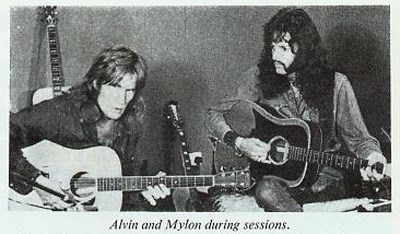
PLAYERS:
The list of
musicians who played on the album is staggering, but Alvin
explained that they “just dropped in”- and see who did:
George Harrison, Stevie Winwood, Jim Capaldi, Ron Wood,
Reebop, Mick Fleetwood, Andy Stein, Bob Black, Tim
Hinkley, Mike Patto, Ian Wallace and
Boz Burrell !
“On The Road To
Freedom” - is important in many senses for Alvin, being
the first album recorded in his new home studio, and the
first brought out by his “Space Productions” production
company. He also feels that the recorded music is a side
of him that’s long been unexpressed, and when Beat
Instrumental went down to his country manor, hidden deep
in the Berkshire countryside, he and Mylon were keen to
tell how their friendship and album came about. Mylon
began by telling how, when they were in the States
together, he and Alvin used to spend hours in hotel
bathrooms – “we used to call it “Bathroom Music” – picking
flat-tops-and generally having a good time with
country-flavoured music. Why in the bathroom?
Well, just think
how good anything musical sounds in the bath and you’ll
see why.
“Our managers
ended up trying to keep us apart, thinking we were a bad
influence on each other. Because we’d miss planes and
sleep just spending the nights pickin´ our guitars,
because you get a beautiful sound in a bathroom,” he said.
Since then, a strong friendship has developed between the
two musicians, and when Mylon came to England in the
summer, he found Alvin hard at work building his studio,
in a barn near the main house, together with friends and
musicians. Everybody worked to get the studio ready, and
in between working, Alvin and Mylon together, with the
musicians previously mentioned, were able to play, record
and get material together. Alvin explained, that when they
started recording there were no definite plans for an
album, and with the tremendous freedom offered by his own
studio, he and Mylon were able to do practically anything
they wanted.
ALBUM:
“We had often
talked about an album in the past, because our tastes are
very similar in a number of ways. We don’t plan albums,
though, we record, and I think that if you can record
freely, and then worry about whether it’s going to be an
album, single, tape or whatever afterwards, it’s a better
approach. When you’ve got to play music for something in
particular, it becomes something else,” said Alvin. “We
wanted to be as relaxed as possible, which you can’t get
when you’re paying 30 pounds an hour. We’re right out in
the country here, and can play and record any time. There
isn’t even a clock in the studio, just so there are no
time worries. Sometimes we’d go in during an evening, and
not come out until the middle of the next afternoon! “When
we started recording, and all these musicians started
dropping in, it was amazing how well they fitted into the
music. George Harrison, Tim Hinckley and Ian Wallace all
live locally and we go round to their music rooms and
studios and play. Some live in London and like to come out
here for a few days´ rest because it’s so relaxing. “It
was very strange at times how everything worked out so
well, at one point we ideally wanted a Nashville steel
guitarist, and then we found there was one in town, and
the next day he was up here”! That was Bobby Black of
“Commander Cody and His Lost Planet Airmen”. “I think one
of the reasons we like the album so much is the fact that
it’s completely home-made, recorded and mixed here, and
even the sleeve shots and design done here. That makes you
a lot prouder of something”. Alvin has always divided his
time between actually playing, and handling the production
side of recording. His interest in the production side
goes right back to when he had his first tape recorder. “I
like machines, in fact cameras, precise machinery, I get
off on that. The production interest stems from wanting to
have more control over what I play. It’s frightening to
think that 30 or 40 years ago it was all mono, with
musicians playing into a horn and straight onto a disc –
the facilities today, with a 16-track, are just amazing,
and I’m still learning. “I’ve also learned a lot just
inviting people down here, because everybody has a
different approach to making and recording music, and most
people have one and stick to it. I’m seeing lots, and it’s
really interesting. I haven’t co-ordinated anything yet
because I’m still learning, but I’m very excited.

APPROACH:
“On The Road To
Freedom” is an approach to music, but what I also want to
get into in the future is using a 16-track almost as an
instrument and supplying sound sources, and taking them
through pipes and around corners, but not like is done
with a synthesiser, which is almost ready-made. I think a
lot more can be done with recorded natural sound. “One of
my heroes in this field is a guy called Tod Dokstod, who
does what he calls “Organised Sound” and he’s even done an
album with an orchestra, but what he did was record all
the different instruments playing different notes, cut the
tapes up, index them, and then fit them together for the
“organised sound” – it’s really amazing. “Being a
musician, I want to use all these advantages. The sky’s
the limit really, with the facilities in this studio. But
you can’t buy time, and that’s what becomes the main
factor”. Although all this seems far away from his
accepted role with Ten Years After, the band’s followers
needn’t worry: “We’ll keep Ten Years After
together for the people more or less. I can’t see the band
as an object, though, because it’s been going so long. A
lot of bands say: “We’ll do this or that,” but Ten Years
After have always been very much into the validity of
following through and progressing at the right pace, it’s
like finding a channel and exploring it, rather than
trying them all. And that may be the success of Ten Years
After – we went out on a limb and stuck with it, where as,
if we had tried to play all the types of music we thought
people would buy, it would not have worked.
BOXING:
“For me, Ten Years
After is like a workout, or a boxing match with a guitar.
I go on and do everything I can with the instrument, and
the rest of the band do the same. It’s quite mind blowing,
but it’s not the sort of music I can sit in the living
room and listen to. “Playing fast is like a reaction
really. When you learn to drive a car, using the steering
wheel and pressing the break and accelerator, it becomes
automatic, and when you get in, you become a part of it.
It’s the same with
the guitar, get in the groove and you’re away. “Some
nights with Ten Years After,
it’s really silly, I can stand on stage and just listen to
myself playing, and think, “Oh! That’s amazing,” and the
guitar seems to be playing itself. The fans are pushing
and I can really let it flow. “I never really try to play
fast, that just comes with time. I might try to play
intensely, but I’m also trying to create whirlpools of
sound, rather than just play notes. I play a lot of notes,
but they’re all based around patterns and chord
formations, up and down the neck.
FASTER:
“There are a lot
of faster guitarist than me, I’ve heard them. Olly Halsall
is very fast and fluent, but people don’t think it’s fast
because it sounds easy, and it slides around.
“Every musician at
some stage, has to decide which direction he’s going to
take, which is what I did when I decided to have these
guitar workouts as my thing, and I’ve really enjoyed it,
but the more ground you cover, the less there is to do.
Things have slowed down a lot now, and we do two major
tours and an album a year, but that’s because it gets
harder the longer you go. “It’s the same with the
instruments. When you start, in the first year you go from
playing nothing, to playing tunes, and the ground you
cover is fantastic. Then you get into style and new licks,
and it all slows down. That’s the state I’m in now, with
that side of my playing, I maybe, pick up a new lick and
work it into some phrases about once a month.
“That’s why it’s
so good having Mylon here, he has all the enthusiasm that
I lack, and it seems anything we say, “let’s have a go
at,” we can do, it’s the way our characters work together.
On my own, I probably wouldn’t do so much, because the
enthusiasm has been washed out of me a bit, but now, I
fiddle around on everything, playing harp, piano, bashing
the drums, it’s almost as if I’ve realized my own
potential, which is quite frightening”.
RED TAPE:
Alvin and Mylon
also hope to go on the road with some of the musicians who
played on the album, but as they explained, there’s a lot
of red-tape involved before ten “known” musicians can do
it. “It seems a crime really, not to get anything on the
road, everyone wants to play, and as far as I know,
everybody who’s heard it likes it. We might go on the road
anonymously. Our attitude was to have something fresh and
musical, and the fact that it comes across on a piece of
plastic is fantastic”.
SPACE:
Alvin’s “Space Productions Company” now allows him to
record other artists and have their albums and material
released through Chrysalis and although he’s looking
forward to recording and producing artists at his studio,
he wants to be personally involved in all that’s done
there, and not use it as just another commercial studio.
It’s situated in a barn near the main house, completely
insulated, with the control room raised up at one end and
the observation window high in one wall. Giant oak
supports reach from the studio floor into the high roof, a
nice “down on the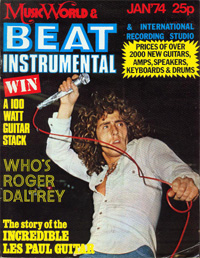 farm” touch, but there the similarity
ends, for the desk and recording equipment are very
sophisticated indeed.
farm” touch, but there the similarity
ends, for the desk and recording equipment are very
sophisticated indeed.
CONTROL:
The control room
features an 18 - channel Helios desk, with two channels
for reductions. It also has
monitor mix facilities, so that one can monitor mix
recordings, while actually listening to it, band or
16-track, without switching to reduction. There’s also a
remote box in the studio with a PPM meter and
slider-fader, so that one man can go in and record
himself.
The desk also has direct injection sockets so that guitars
and other instruments can be plugged straight in. The
recorders consist of a 16-track Studer with Dolby M16, A
Studer two-track and two Revox machines and both Tannoy
and JBL’s because most American musicians are used to
them.
Your Letters
and Queries
1. Dear
Beat Instrumental, I would be very grateful if you could
give me details as to where I may find information on the
design and circuitry of “humbucking” pickups and their
advantages. You have helped me before and I hope you will
help me again.
From Andy Wason,
Wishaw, Lanarkshire.
2. Dear
Sir, I have been intrigued for some time now about guitar
pick-ups. However, I have been unable to convince myself
why some guitarist alter their pick-ups when they already
have perfectly good ones which came with the guitar. For
example, guitarist Alvin Lee of Ten Years After, altered
his Gibson Humbucker pick-up for a conventional make and
also Clem Clempson of Humble Pie had a different pick-up
fitted to his Gibson Les Paul. Is this something unusual,
or something to do with the sound? Also, please could you
tell me what is a better pick-up to replace a Gibson
Humbucker on a Les Paul, and what types of pick-up Alvin
Lee, Clem Clempson and Jimmy Page use now.
Yours faithfully,
Wilhelm Heidenoldendorf, West Germany
Reply To The
Questions Above:
The main feature
in humbucking pick-ups, is the use of two magnetic poles
under each string instead of one, resulting in a fuller
sound and the cutting of hum and extraneous noise, very
useful in a recording situation. Single-pole-pick-ups give
a thinner tone generally, but the actual strength of the
output is dependent on pole size and the windings. One
guitar which can be switched to either single – or double
– pole operation is the new Dan Armstrong six-string
model, which has a single sliding pick-up.
We couldn’t
contact either Clem Clempson or Jimmy Page, but Alvin Lee,
who uses a Gibson ES-335, has two humbuckers fitted, and
one Fender Strat pick-up (single pole), situated between
them. The Fender pick-up is wired to a separate volume
control, and wired in parallel with the bridge humbucker –
that’s how he gets that variety of sound!
For further
details on humbuckers, we suggest you write to Henri
Selmer and Co. Ltd. Woolpack Lane, Braintree, Essex.
|
| Record Mirror - January
26, 1974
Peter
Harvey Meets Chick Churchill:
The fact that
Chick Churchill can sing has probably never occurred to
fans of Ten Years After.
Chick always appears to be a phantom figure, stuck behind
the organ, while Alvin Lee takes the spotlight. For six
years now, he’s let his music speak for him, but early
last year he decided that Ten Years After was no longer
enough, and though the event passed quietly enough,
towards the end of the year, Chick produced a quite
distinctive solo album. That he did after discovering his
own voice didn’t do his songs justice hardly matters, it’s
the sensitive thoughtful nature of his work that provides
the impact. After all, you’d hardly expect gentle music
from the keyboard man in one of Britain’s raunchiest rock
`n´ roll bands.
Luckily, the voice
problem turned out to be a blessing in disguise too. Since
they are such a matey (close / friendly) lot at Chrysalis
Records, Chick was able to pull in one of his stable mates
in order to present the songs. Ravers are sure to know
the singer, Gary-Pickford-Hopkins – the wild Welshman who
fronts the Jethro Tull spin off band, “Wild Turkey”.
But once again
this is a familiar face in an unusual guise. To be fair,
Chick did sing on two of the songs, just to prove that he
could do it, but for the rest of the album it’s Gary out
front, while Chick plays his own compositions /
arrangements and watches over the production too.
Up in the control
room here at Morgan Studios, he was pouring over the desk
doing a re-take on one of his songs, looking for all the
world like a seasoned engineer. “I’ve learned a hell of a
lot about recording if nothing else,” he admitted, taking
a short break while the back-up vocals trio, consisting of
three very lovely ladies, had a breather. Chick explained,
that the track they were working on, “Broken Engagements”
had failed to show up as a single in Britain so, “soulful
harmony singing was being added” at this moment, in order
to boost its chances in the American Music Market. They
worked over the track again and again, and to be honest,
it’s haunted me ever since. His songs are all like that:
maybe a little weak upon your first listen, but given a
respectful amount of time, eventually they stick in your
head.
In between the
takes, Chick managed to provide the story behind his
remarkable musical about face. “I had been writing songs
for about two years and I had collected quite a few when I
decided one day to listen to them all. I found that I
didn’t like any of them, so I sat down and wrote twelve
new ones and that’s the album. Sounds simple doesn’t it?
But having taken on the project, Chick characteristically
went about it with a thoroughness that is well known to
his friends. What most people don’t realize, is that Chick
Churchill is a Classically trained musician, so he got
right down to it and wrote / did the strings arrangements.
“It had been six
years since I had done anything of a classical nature, so
I was a bit rusty, but I really wanted to do it. I suppose
I was a bit fed up, as I had got to be known as a backing
musician. People are going to be a bit surprised by the
songs, basically I just had something in me that I wanted
to get out and couldn’t get it out with Ten Years After”.
Chick laughed when I wondered if this solo project might
produce problems. “No, it doesn’t matter how successful
the songs are, I’m always going to play with Ten Years
After – though maybe they would let me do a solo spot”. He
says he’s not after Ten Years After fans, and if they
should buy the album out of curiosity, it’s sure to be a
surprise. There’s a fair number of ballads on there, with
thoughtful lyrics and melodic lines, and throughout Chick
plays, piano, organ, electric piano, mellotron and even a
Moog Synthesizer. He’s joined on this album, by what
Chrysalis describes as their “Central Casting Call” some
of the best musicians who record for the record label:
There’s Bernie Marsden from the band “Wild Turkey” and
Martin Barre from “Jethro Tull” on guitars, Cozy Powell
from the band “Bedlam” and Ric Lee and Leo Lyons from “Ten
Years After” Ric drums – while Leo shares bass duties with
Rick (Roger) Hodgson from “Supertramp”.
Chicks wife was
also in the recording studio watching all the activity,
and she confided:
“That when Chick becomes interested in something, he has
to become an authority. He suddenly took an interest in
meteorology and we ended up with a weather station on the
roof of the house…………but this is the best thing he’s ever
done”. |
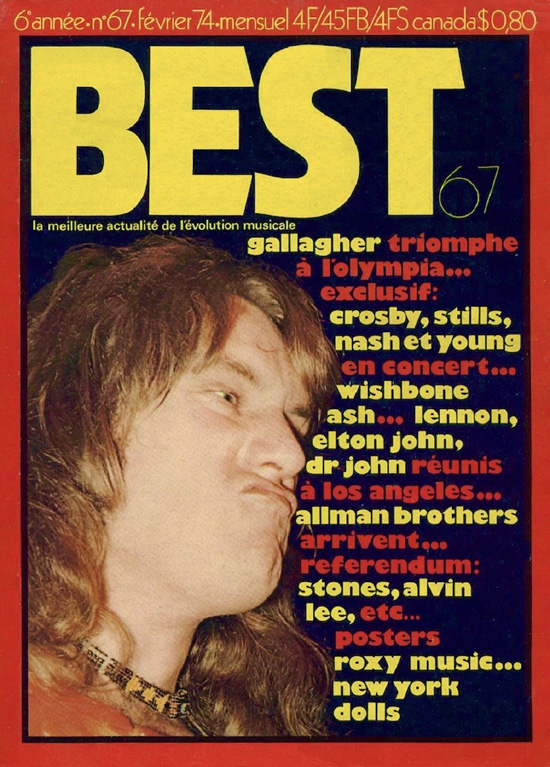
February 1974 - French
Magazine BEST, No. 67
Many Thanks to
John Tsagas and Christoph Müller
|
Sounds Magazine – February 2, 1974
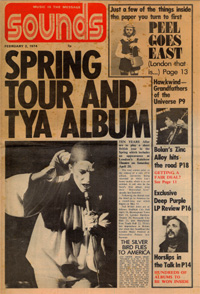
Ten Years After
News – Spring Tour and Ten Years After Album
Ten Years After
are to play a short British Tour in the Spring, which
includes an appearance at London’s Rainbow Theatre on
Saturday April 20, 1974
The tour comes
prior to the release of a new Ten Years After album,
currently being recorded at Alvin Lee’s home studio
(space-studios) which is as yet untitled. (Positive
Vibrations – will eventually become the title of this
album). It will also be the band’s first album since
their
“Recorded Live”
double album released last Summer.
Following the
British Tour, the band go to America for a month - long
tour, which begins on May 15, 1974.
Full British
dates are as follows:
- Sheffield
City Hall – April 18th
- Birmingham
Town Hall – April 19th
- London
Rainbow Theatre – April 20th
- New Castle
City Hall – April – 21st
- Manchester
Free Trade Hall – April 22nd
Ten Years After’s last appearance in Britain, was when
they headlined the London Music Festival at Alexandra
Palace last Summer. |


page 32 & 33


page 34
|
March 2, 1974 - New Musical
Express
News Desk – Alvin
Lee Rainbow Headliner
Alvin Lee is to play a solo concert at London Rainbow
Theatre on Friday, March 22 (box office opens this week),
with a band of guest musicians.
This gig takes place
exactly a month before he returns to this same venue as a
member of Ten Years After for
their sold-out concert there
on April 20. Explained Lee this week: “The musicians I
have recently become involved with at Space
Productions
Recordings have shown so much potential that I feel this
is something which
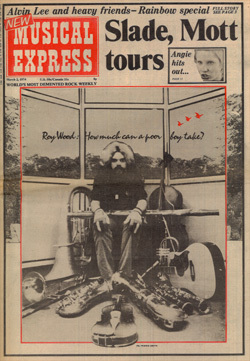 should be made available to a live
audience. If this concert is as good as I think it will
be, I hope to be involved with more in the future. I am
trying to escalate my involvement with as many musicians
as possible”. Although the musicians who will back Lee at
the Rainbow have not been named, it is significant that he
originally formed Space Productions to record his album
with Mylon LeFevre and guest on that included: Ronnie
Wood, Steve Winwood, Jim Capaldi, Ian Wallace, Mick
Fleetwood, Mike Patto and the mysteriously-named Harry
Georgeson. A track from the Lee – LeFevre album is
released by Chrysalis as a single on March 8th
– it is the George Harrison song “So Sad”. But it is
stressed that Lee is not leaving Ten Years After – in
fact, they are currently recording at his own studios, and
they have a new album coming out in April. (Positive
Vibrations). should be made available to a live
audience. If this concert is as good as I think it will
be, I hope to be involved with more in the future. I am
trying to escalate my involvement with as many musicians
as possible”. Although the musicians who will back Lee at
the Rainbow have not been named, it is significant that he
originally formed Space Productions to record his album
with Mylon LeFevre and guest on that included: Ronnie
Wood, Steve Winwood, Jim Capaldi, Ian Wallace, Mick
Fleetwood, Mike Patto and the mysteriously-named Harry
Georgeson. A track from the Lee – LeFevre album is
released by Chrysalis as a single on March 8th
– it is the George Harrison song “So Sad”. But it is
stressed that Lee is not leaving Ten Years After – in
fact, they are currently recording at his own studios, and
they have a new album coming out in April. (Positive
Vibrations).
|
| March
1974 - Pop Magazin Aktuell

Woodstock machte Alvin Lee
Gitarrengiganten, zum ungekrönten „Speed - King“ auf sechs
Saiten. Eine Rolle, die er während langer Zeit genüsslich
auskostete, jedoch eines Tages völlig über hatte. Der
Musiker in Lee verlangte sein Recht und seine
Befriedigung.
Der Ten Years After - Boss rückte
plötzlich mit Sprüchen raus wie „Ten Years After sind
nichts anderes als eine reisende Juke-Box.“ Schock bei den
Mitmusikern, Schock bei den Fans. Lee bewegte sich in der
Folge immer öfter auf Solopfaden; Jamsession mit allen
möglichen Leuten , bloß nicht mit den Musikern seiner
eigenen Band. Im vergangenen Jahr dann kam eine
Gemeinschafts- LP mit dem amerikanischen Gospelsänger
Mylon LeFevre auf den Markt. Die Klatschtanten hatten
Hochsaison. Ten Years After am Ende?

Und heute, 24 Stunden vor dem
Alvin-Lee-Solokonzert im Londoner Rainbow (Begleitmusiker:
Boz BurrelHinckley, Ian Wallace, Mel Collins, kein
Mitglied von Ten Years After), überkugeln sich die
Splitgerüchte einmal mehr. Alvin selbst dementiert zwar
Trennungsabsichten nach wie vor, wenn auch nicht mehr mit
dem gleichen Nachdruck wie ehedem: „Ich werde sicherlich
nicht derjenige sein, der über das Schicksal von Ten Years After entscheiden wird.
Dazu habe ich kein Recht. Sollte eine Trennung wirklich
beschlossen werden, muss dieser Entscheid von der ganzen
Gruppe gefällt werden. Ich gebe zwar ehrlich zu, dass Ten
Years After allein mich nicht ausfüllen könnten und dass
ich meinen momentanen Solo-Projekten erheblich mehr
Befriedigung abgewinne. Trotzdem bestehen nach wie vor
keine konkreten Pläne, Ten Years After aufzulösen. Es kann
jederzeit etwas passieren, das die Gruppe wieder
zusammenbringt...oder sie vielleicht auch vollends
auseinanderreisst. In Kürze wird ein neues Ten Years After
Album auf den Markt kommen: (Titel) „Positive Vibrations-“
erscheint bei uns Mitte Mai). Für April ist eine
Englandtournee geplant. Im Juli gehen wir nach
Deutschland, Skandinavien, und Amerika. Was nachher
geschieht, weiß kein Mensch. Abwarten...Vielleicht finden
wir eines Tages den richtigen Rhythmus wieder, vielleicht
auch nicht...“
Dass die Fans auf letztere Lösung hoffen, steht jetzt
schon fest; denn wenige Tage, nachdem die
Vorverkaufsstellen für das TYA-Konzert im Londoner Rainbow
geöffnet worden waren, war die Halle bereits bis zum
letzten Notsitz ausverkauft. |
|
New
Musical Express
-
March 9, 1974
ALVIN LEE SOLO?
 Will
Alvin Quit Ten Years After? Will
Alvin Quit Ten Years After?
Despite
Official denials, the New Musical Express understands
that
Alvin Lee is seriously considering leaving Ten
Years After – following their short British Tour next
month – to embark upon a solo career. As exclusively
revealed last week, Lee is playing a solo concert at the
London Rainbow on March 22, 1974 and is apparently
regarding this as a trial gig which, if successful,
could hasten his decision to quit the band.
A
friend and fellow musician of Lee’s told New Musical
Express this week: “Alvin would have gone solo some
time ago, but he lacked the confidence. We’re all
hoping that the Rainbow gig will give him that
confidence.
If it works out satisfactorily and he gets
good reviews, he tells me he will then take the plunge
as a soloist. His contract has now expired, so there’s
nothing to prevent him doing so.”
Chrysalis,
on the other hand, insist that Lee is still an integral
part of Ten Years After, and point out that the band are
at present recording at Lee’s own private studio. A
spokesman said he had “no reason to suppose” that
Lee intends on leaving.
Meanwhile,
Lee has now fixed his backing group for his March 22nd
concert at the Rainbow. It comprises of bassist Alan
Spenner, and guitarist Neil Hubbard (both former Grease
Band members), ex-Vinegar Joe keyboards player Tim
Hinkley, and two ex-King Crimson men, Mel Collins (horns)
and Ian Wallace (drums), vocal backing are by Kokomo.
|

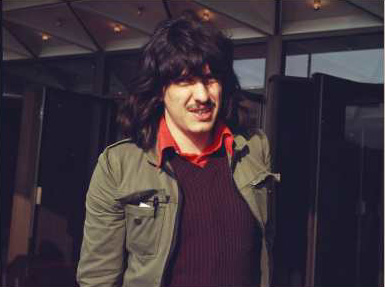
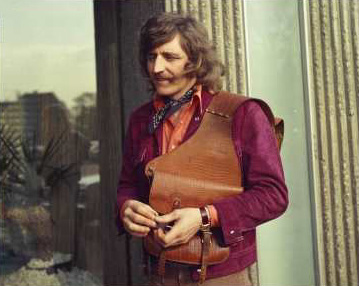
|
March 9, 1974 -
Billboard Magazine
Ten Years After
Tour of United States Set:
New York –
Premier Talent Agency here announces that it has set a
one-month U.S. concert tour for Ten Years After,
Columbia Records act. At least twenty one cities are on
the schedule, which kicks off in Boston in mid-May and
will continue through mid-June.
One-nighter tour
will also include two dates, each in Boston and San
Francisco, as well as a headliner show at Radio City
Music Hall here in New York City. The band is currently
working on a brand new LP, it’s expected to ship prior
to the upcoming tour, while leader Alvin Lee is also
working with Mylon LeFevre on a follow up to their 1973
Columbia album, “On The Road To Freedom” – as a duo.
|
|
New Musical Express - March 16,
1974
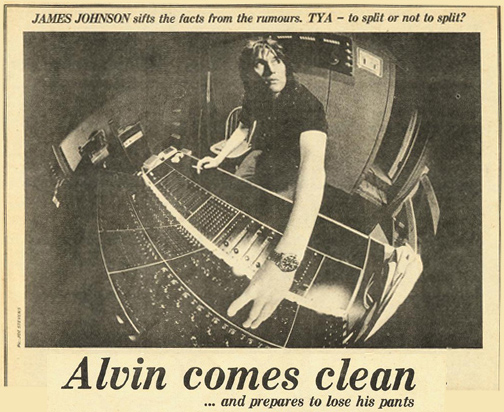
Monday Afternoon in Reading, and the time seems right for
Alvin Lee to come clean. With a Rainbow concert set for himself and “friends”, plus rumours of a possible solo
career, it’s been looking more and more likely that
Ten Years After are finally about to self-destruct.
Lee’s activities lately have been somewhat hard to follow.
Over the last year he’s drastically cut down his work
with TYA, recorded an album with Mylon Le Fevre----a white
gospel singer from Georgia who still “believes”
despite some varied drug experiences –and is currently
recording with musicians like Boz, Tim Hinckley and
Ian Wallace. Add to that the fact that Lee has not exactly
been over complimentary about Ten Years After,
after referring to them as “a travelling jukebox,” quite
frequently, and not with any great affection.
So what goes on?
“ONLY ALVIN might have some ideas on that.” muttered a
stray engineer, toying with various mechanisms at
Lee’s Reading home studio and indicating a certain amount of
bewilderment himself. This was before Alvin
himself lumbered in a few moments later, wearing the usual
clogs and denims but looking a good deal fresher than he has for some time. One feels that although Lee isn’t
the most obvious rock casualties, his experiences
of almost continual touring with Ten Years After left him
stunned for a spell.
Right through he hung on to a sort of South Yorkshire accent
–pronouncing fun as ‘fon’—but the whole Woodstock
Guitar-Hero phase and the huge amounts of money that rolled in
afterwards left him with a general blankness.
He firstly found it difficult to cope, then later once
explained how he found it hard to relate to anybody outside
the rock world at all. At the time, he over compensated for
that with a kind of flashy panache that quickly became transparent, especially on
stage. Subsequent attacks on
the size of his ego no doubt added to his discomfort.
Now he appears more acclimatised, and he’ll be the first to
admit that his work outside TYA and in his own studios
with musicians of his choice has been what’s really helped
him out.
Meanwhile, the rest of his house and property—the acres of
ground, stables, and rows of greenhouses—go more
or less ignored except for the attentions of a couple of
gardeners who toil away daily, apparently oblivious to the
musicians who come and go. Lee has also had to devote time
lately to the promotion of his album with Mylon.
Also on the Rainbow concert since his record company,
Chrysalis, didn’t seem “over-interested” in either
project. There’s the distinct impression that as they’re basically
Ten Year’s After’s label, they don’t want to get
involved in
anything that might split the band for good, presumably
feeling that TYA still have a few more profitable years
to run. It seems to have been left to Lee himself to look
after the advertising and the organisation of his solo work.
Ironically, Lee feels his activities outside the band have
really saved TYA—and right now he claims he has no thoughts of
leaving. “The fact is. I don’t think Ten Years
After would be going now if I hadn’t had the opportunity to do something
else. Last year there was no doubt it was
getting predictable, but you really can’t fight that. You
can’t suddenly say: ‘Right, we’ll go on the road with a
new sound, new material and new attitude. ‘You can’t just
do that to order. “I’m not going to be the one to say Ten
Years After is finished because I don’t really think it’s
up
to me to do that. It would have to be up to the band as a
whole. “Truth is, I’m just not satisfied playing for them alone and at present I get more satisfaction out of these
other things. But there are still no plans to specifically break TYA up. At any time there could be something to put them
together or tear them apart, I don’t know.
“There aren’t many musicians who can play in about three
different bands at once, but I don’t see why it can’t
be done or why I shouldn’t try. All I know is that something
like the Rainbow concert is better than sitting
at home watching TV or going out on the road playing all the
same old numbers again. “There’s nothing to suggest
that if the Rainbow concert is a success then I’ll become a
solo performer. Playing with a few different musicians
has just meant that I’ve learned more in the last year than
I have in the previous four, which can only help Ten Years After.”
ACCORDING to Lee, the new album TYA recorded with the hopeful
title of “Positive Vibrations” is more constructive than recent records. Again, he says, the home
studio has helped in allowing the band more time
to come up with something new. It seems they’ve even been
moving a little away from the usual, almost
standard 12 bar rock/blues. “I mean, we’ve tried to avoid
just jams and verse-chorus numbers, I’ve tried to
play the role of producer more and tried to create something
more structured –to think about it more in advance
rather than to just let everybody play it, and how it comes
out is the finished product. That’s what’s happened
in the past.” He closes the subject for the moment by saying
he doesn’t really see very much point in talking
further about TYA, since the Rainbow concert is uppermost in
his mind. But he still hasn’t formulated any
particular plans on what will take place. As yet, only the
line-up is roughly settled. The material has yet to be
worked out. “It’s not going to be the heavy rock that
people expect from Ten Years After it’s not going to be the sort of country stuff from the Mylon album—it’s going to
be something completely different again.” He says definitely. “We’d
thought we’d play the gig simply because we’ve been having
such a good time in the studio. It’s the obvious thing to do—almost it’s an alternative.
“Then, in July, Mylon’s coming over again and we’ll
record another album and play a proper tour. That’s another
alternative. It’s been a year of alternatives really.”
Lee’s whole demeanour as he discusses his options contains a
noticeable dead-pan lack of excitement. His
equanimity is as such, you feel if he witnessed the end of the
world, he’d make it rather sort of matter of fact.
Since a number of notable names turned up on his album one
wonders if they’re liable to show up at the concert. Hari Georgeson for
example, alias George Harrison. That’s
unlikely because from Lee’s remarks, he now
appears rather embarrassed about his connections with Harrison
altogether. “It’s really something I want to
avoid in a way, because I want this concert run for the sake
of the music rather than the names. It’s nice to play
with great musicians but often people take more notice of
their names than what they play. “With all due respect
to George, his song ‘So Sad’ on the Mylon album is great—but
I don’t know whether it’s
representative of the
album as a whole. You know, he just came down for a couple of
nights, we recorded it and that was that, and he
said we could do what we liked with it. “But then, everybody
connected with the business wanted it to be the
single, and I’m sure George’s name was the weight—not
the song. However, they insisted on it in America. “Now
it’s been released as a single in Britain which just shows
it’s sometimes difficult to differentiate between the music
and the selling potential. “On the Rainbow gig the selling
potential is irrelevant as far as the musicians are concerned. We’re prepared to lose our pants on it. I’m not
making any concessions at all.”
SO ALVIN’S not just in it for the money, as has been
suggested on a few occasions in print? “Oh that was an American article—Lester
Bangs. You can’t believe anything
he says. “Money’s just a reward—not a motivation. The only pressure there happens when your manager
comes up and says: ‘Oh you ought to do a tour
now otherwise you’re going to be in the red’. That does
happen. Now the Lee really does look like lifting himself out of the
stodgy format that is Ten Years After, presumably the
rest of the band are also rather concerned. Ric Lee, Leo Lyons
and Chick Churchill must be feeling a slight draught, despite Lee’s denials that he’s about to leave
them. “Maybe all this has caused some difficulties between
us, but there were difficulties anyway. There was resentment
last year when I wanted to take three months off and not go on tour.
“At present we have a new album to release, a British tour set up, and it’s just a matter of
following that through. Afterwards we’ve got no plans—things
might work out, they might not. “You must remember that they’ve all got their own projects as well.
Chick’s got his solo album: Ric is managing a band:
and Leo’s playing some sessions. It’s not like they’re
all totally dependent on TYA. “Personally I couldn’t have
survived much longer without doing something outside the band.
I was lost. I used to think once you’ve become a success—that’s
it, you could relax. But I found I really
wanted to be out working. The fact that I didn’t know how
to do it just made it worse.” occasions in print? “Oh that was an American article—Lester
Bangs. You can’t believe anything
he says. “Money’s just a reward—not a motivation. The only pressure there happens when your manager
comes up and says: ‘Oh you ought to do a tour
now otherwise you’re going to be in the red’. That does
happen. Now the Lee really does look like lifting himself out of the
stodgy format that is Ten Years After, presumably the
rest of the band are also rather concerned. Ric Lee, Leo Lyons
and Chick Churchill must be feeling a slight draught, despite Lee’s denials that he’s about to leave
them. “Maybe all this has caused some difficulties between
us, but there were difficulties anyway. There was resentment
last year when I wanted to take three months off and not go on tour.
“At present we have a new album to release, a British tour set up, and it’s just a matter of
following that through. Afterwards we’ve got no plans—things
might work out, they might not. “You must remember that they’ve all got their own projects as well.
Chick’s got his solo album: Ric is managing a band:
and Leo’s playing some sessions. It’s not like they’re
all totally dependent on TYA. “Personally I couldn’t have
survived much longer without doing something outside the band.
I was lost. I used to think once you’ve become a success—that’s
it, you could relax. But I found I really
wanted to be out working. The fact that I didn’t know how
to do it just made it worse.”
The future will tell how successful are Lee’s efforts to
escape the role
of super-speedy guitarist with which he
looked like being saddled for eternity. Up to now the only
offering available is the Lee-Mylon album, a pleasant if not classic
record. Meanwhile, the future of Ten Years After continues to hang tenuously in the
balance.

New Musical
Express - March 16, 1974 |
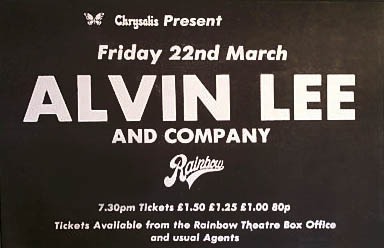

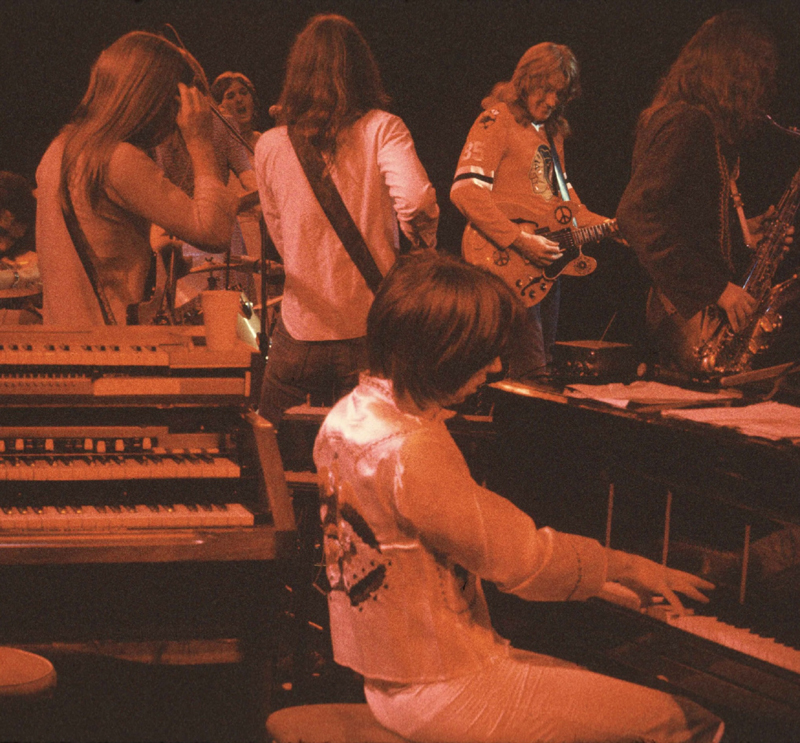
22 March 1974 -
Alvin Lee & Co. at Rainbow Theatre, London
|
New Musical Express - March 23, 1974

 U.K. Tour By Alvin
& Mylon U.K. Tour By Alvin
& Mylon
As speculation
mounted concerning the possible departure of Alvin Lee
from Ten Years After to pursue a solo career, he revealed
to the New Musical Express this week, that he is planning
a full concert tour with Mylon LeFevre in the early
summer. Said Alvin: “Mylon is coming over so that we can
record another album together, and we are planning a
series of gigs for around the July period”. Meanwhile,
Alvin’s solo concert at London’s Rainbow Theatre tomorrow
(Friday), when he will be supported by a pick up group of
“Friends”, (see photo)
is to be recorded for release in two or three month, as a
live album.
It is possible that the live material will be supplemented
by a few studio tracks. The concert is also being filmed
by the independent “Tattooist Company” for distribution
throughout the United States and Europe, though it is not
yet clear if it is intended for T.V. or cinema screening. |

Many Thanks to Claudia Staehr (from Herb's Collection)
|
Record Mirror – March 23, 1974
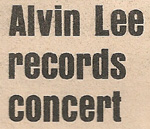
Alvin Lee Records
Concert
Alvin Lee’s Rainbow concert this Friday is to be recorded
for a live-plus-studio tracks album, set for release in
two or three months time. The event, which has been
stressed as a one-off project, will also be filmed by an
independent company for world wide release. With Alvin Lee
will be Alan Spenner, Neil Hubbard, Tim Hinkley, Mel
Collins and Ian Wallace.
|
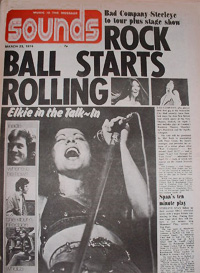
| New
Musical Express – March 30, 1974

Alvin Lee’s
concert at the Rainbow Theatre on Friday was an unusual
event to say the least. It’s not often that a major rock
star artist takes quite this kind of step in attempting to
break out of a musical impasse, and the presence in the
audience with the likes of the one and only
Paul McCartney,
George Harrison, and Rod (The Mod) Stewart all added to
the heightened sense of the occasion.
The band behind
Alvin was made up of top shelf talent, that included Ex-
King Crimson (Crimzoids) Ian
Wallace (on drums) Mel Collins (sax / horns / flute/) and
from Vinegar Joe, Tim Hinckley
(Keyboards) along with the man nucleus of Kokomo, which is
the very latest in a line of British attempts to get
closer to real American music with a loosely formed band
that that is heading towards sneaky, underhanded and
backdoor funk.
As might be
expected, the overall result was an unruly assorted blend
/ mixture of rough edged blue eyed soul combined with
Alvin’s white tea sipping English rock / blues.
It proved to be a
fairish enough combination, to be honest. Even though one
felt there was a struggle for good material towards the
finish line.
With Alvin looking
incredibly nervous at the beginning, he wisely didn’t
overly force his hand, his personality, or push his guitar
work into the show. The entire idea was obviously one of
an integrated band, performing as the meat and potatoes of
the evening, while Alvin added the butter and spices as
needed. He expected the band to support itself, without
him as the front man, Alvin preferred to be one of the
boys in this group. The problem was, that when he did
stand down from the spotlight, things tended to
disintegrate. An example was the number when Alan Spenner
supplied the vocals. While Spenner is a great bass player,
the only bassist, or so legend has it, to be offered a gig
by Motown, but he still needs some more experience as a
lead vocalist.
However, for the first half of the show, the band put in
some very sharp playing and spurred right along by some
great back-up singing supplied by Frankie Wilson, Dyan
Birch and Paddy McHugh. On a number such as “Step Back”
(the writer means “Let’s Get Back”) Alvin put in some very
poignant economical guitar playing. It was a largely
different stance, compared to his prominent role in Ten
Years After. With completely new material to perform and
despite some calls from the audience for “Going Home” on
different occasions the goal for the evening remained straight forward and right on track. This part of the show produced some excellent songs for the live album that was being recorded.
Things became weaker when Alvin indulged himself with a few Elvis Presley impersonations on “Don’t Be Cruel” with the back up singers adding a taste of the old Jordinaires backing sound. From there the band went head on – straight to rock `n ´ roll which, as usual stimulated the crowd into varying stages of frenzy, but it all seemed lame compared to what had gone down before. Anyway, Alvin Lee and Company had already proved their point, and the project was a fair success, so in the end, nothing was really lost.
Article by James Johnson (additional text and corrections added where needed)
|

|
From
Sounds Magazine 1974
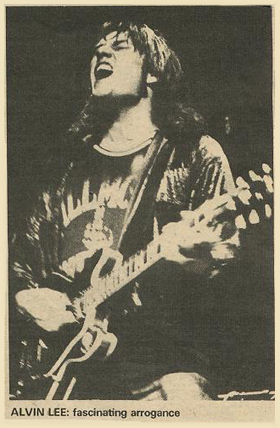
ALVIN
LEE CONCERT – NOT MUCH HAPPENED:
Alvin
Lee and Company:
At
the Rainbow – hmm – a bunch of good people but was it a
band? Much as I’d like to say yeah it was, and Alvin Lee had
found a new path to follow after years of thrashing and
grinding the circuit with Ten Years After, it didn’t really
work. However much it might not have been intended, the show
still had an uncomfortable aura of Star and Back-Up Musicians:
it was partly due to a curiously flat feeling from the
audience, which wasn’t helped by your die-hard Ten Years
After freaks yelling for boogie and partly I think because the
people on stage never really loosened up. From out front, it
felt as if everyone was holding back, being just that little
bit too polite to each other for the music really to feel
right. It was an odd feeling. All the component parts were
right, and you’d be hard pressed to put together a better
British Band than, Alan Spenner, Neil Hubbard, Tim Hinkley,
Mel Collins, Ian Wallace and the three KoKoMo singers –
unless of course you went for KoKoMo itself or a revived
Grease Band – but somehow for most of the evening it added
up to less than you’d expect.
You
couldn’t fault it from a purely objective point of view, and
yet I only felt my appreciation move from head to heart as
well for a couple of numbers. The most notable was Alan
Spenner’s old Grease Band tune “Down Home Momma” – not
just because it was Alan out front, but because it was one of
the few times when they all including Alvin, played as a band.
Another
was the Alvin Lee song just before that, though I didn’t
catch the title. But those were relatively early on in the set,
and afterwards it dropped into a competent but unexceptional
groove. For the most part I found myself listening to
individuals – particularly Mel Collins and the Spenner /
Hubbard powerhouse – rather the band.
Shame
– I’d been hoping for a really goodnight, but after it was
all over I felt as if nothing much had happened.
By
Steve Peacock
|
|
 Record Mirror March 30, 1974
Record Mirror March 30, 1974
Alvin
gets it out of his system:
SUCCESS IN TERMS of wealth for Ten Years After
guitarist,
Alvin Lee, is a 500 year-old manor just outside
Reading. It stands in 50 acres of farmland which he lets out.

His white Porsche is parked alongside a fleet of
Wagons. Alvin is busy getting things together in his studio, (a
converted outhouse) for his solo concert, which took place
at London’s Rainbow theatre last Friday. A concert which has
caused considerable speculation as to whether TYA is on the verge of breaking up or perhaps Alvin is
contemplating leaving.
As I make my way into an ultra modern kitchen I’m nearly
knocked off my feet by Alvin’s enormous Irish wolfhound. Alvin comes through and after few words of greeting
he shows me into a very medieval looking
lounge. It’s dark and much of its décor is wood carvings.
Alvin lights up a cigarette and settles himself on the settee. “People thought because I was doing this solo
concert TYA were breaking up, but in fact this is
preventing that,” he assures me after putting the obvious
question to him.
“I’ve found that all my musical frustrations and things I
wanted to do were channelled into TYA which is
unfair. TYA is a unit to me which exist quite happily within
its own scope and I don’t want to start saying
I want TYA to do these numbers and begin changing the format
of TYA. I’d rather do it outside and leave TYA as the music making group it is. By doing this it gets it out
of my system.” Discussing the music he would be playing at the
Rainbow, Alvin
said it was going to be quite different from
what he’s been into before. “It’s different to TYA and
the album I did with Mylon Le Fevre, On The Road To
Freedom, which was basically country. This is more funky R
& B using background singers,” he explained as
he chain-smoked. “I’ve chosen a lot of material I had
which suits this line-up and some I’ve written specially
for it. Altogether we will have spent just one and a half
weeks rehearsing here at my studio. The whole thing is a test to see if it can be done and hopefully I’ll do things
like it more often.”
Lee fans will be pleased to know that he’s recording a live
album at the concert and also getting the event on film.
What
are the chances of taking the Alvin Lee show on the road?
“We’re
thinking of doing a couple of clubs afterwards, but I have a
TYA tour in the middle of next month which
takes me through to July. It would be very easy to take this
band on the road because we’d all be rehearsed, in
fact I could set on a world tour, but I don’t want to get
that involved.” Alvin describes what he’s doing at the
Rainbow as much quieter than TYA which he says is a bit of a
barnstorming band. “With
TYA you really go wild,
freaking out and do everything you can. This concert is
getting into more tasty things with structured arrangements,” he
adds. What a lot of people fail to realise is that Alvin is not the
only member of TYA with interests outside the band. As
Alvin pointed out they have all got other things going. Leo
Lyons has been involved in producing UFO, Chick
Churchill has done a solo album and Ric Lee has a drum clinic
going.
I raised the question had TYA ever thought about changing
their format?
“We had lots of criticism from the press saying that we
weren’t progressing, so we sat around and talked about it,
answered Alvin. “I said that our original concept was that
we never played the music people wanted us to play
and it would be a mistake now to start playing what people
wanted, particularly the press. We did a gig about six weeks after one of our American tours which we didn’t
rehearse, it was just like stepping out from a holiday and we really enjoyed it because it was
fresh. It was a great
gig and everyone was happy and to me that
confirmed we shouldn’t change our music. The music develops into its own thing—if we say we’re
going to do this kind of music then it’s a false change and
not a progression.”
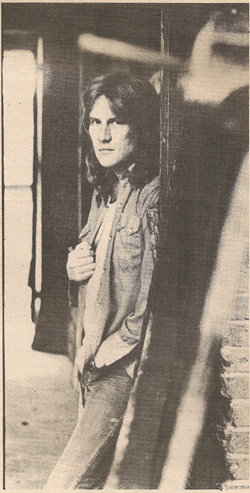
Alvin recently described TYA as a travelling juke box, a
remark which I asked him to expand on. “That wasn’t
meant as a detrimental remark,” he said. “It’s just a
natural reaction from playing every night. Touring with TYA
is like going on manouvres,
it’s not like my original concept of being a musician.”
“You’re due on every night at a
set time and you have to play.” “My prime motivation in
making music was not to be a rock ‘n’ roll star or an
entertainer or be out on the road every night, it was to be
involved with musicians and creating music.”
Alvin who made his first public appearance as a guitarist when
he was 14, was with the band at the historic
Woodstock festival. Hardly surprising is the fact that he and
TYA didn’t enjoy playing once the film was released because a lot of the audience came simply to see what they
were about after seeing them on the film. “I was very
surprised at the impact Woodstock had, it was in the middle of
a tour for us,” Alvin recalls. “We’d done a few big
festivals and Woodstock itself was fine. But when the film
came out about five months afterwards it put us in a
whole different category. The film put us on a different track
since it took our last number of the show which was
a heavy rocker and established us as a rock ‘n’ roll band
to all those people who saw it which wasn’t really the truth. It might have been more representative on reflection. I
wasn’t aware a film was being made at the time.”
In Alvin’s mind the new TYA album, Positive Vibrations is
the best they’ve done. “I’m quite looking forward
to going back to TYA because it’s going to be almost like a
rest for me,” says Alvin. “TYA now works so smoothly, there’s very few hassles because we’ve worked so
much—we’ve done 18 US tours—you just go out
there and do it, there’s no worries ‘cos everyone knows
what they have to do.”
Did Alvin think TYA perhaps neglected Britain a bit?
“In retrospect looking at what there’s available to do,
no” he replied. “You can cover England in about 12 gigs. I
like playing Britain because to me it’s like the roots of
what I’ve ever done, I understand the British audience.
They’re not as demonstrative as American audiences, most
bands prefer playing in the States. The halls here are inadequate to say the least—apart from the Rainbow and
Sundown everything’s like town halls.” Alvin surprised me by saying TYA wasn’t as loud as people
think, he only uses a 100 watt amplifier. “The volume we do get comes out of the sound system and that’s
just a matter of turning it up to what ever’s
necessary. It doesn’t help anybody if you’re hurting
people’s ears—that’s not the way to put music over.”
Finally before Alvin had to take his leave since everyone was
ready in his studio for rehearsing the Rainbow
concert, I asked him if he’d ever ‘hang up his guitar’
as you might say. “It’s nice to have lots of people
listening
to what you do, I’ll always be playing in pubs if that’s
all I could do.”
Article
by ROY HILL
|

Teen
Magazine – March of 1974
Young
n´ Loving
Fifty Cents
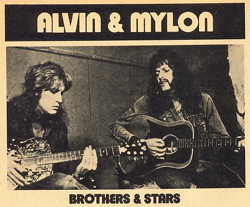 Alvin
and Mylon – Brothers and Stars: Alvin
and Mylon – Brothers and Stars:
It’s
an old but beautiful story, the friendship of Alvin Lee and
Mylon LeFevre.
There’s
Alvin: lead guitarist and star of Ten Years After; tall,
blond, stolid Sagittarian; very together English guy. Then
there’s Mylon: blues singer, black-haired, admitted Libran
eccentric; a Georgia boy newly clean from years of heroin
usage, who drawls: “If it wasn’t for my friend here, I’d
be dead.” The friend-Alvin-looks embarrassed and talks about
the new album they’ve made together that’s called “On
The Road To Freedom.” (1973) It’s likely no work’s been
more aptly named, because for both it marks a liberation:
Alvin from the artistically stifling confines of the band Ten
Years After and Mylon from the far worse restricting terrors
of drug addiction. I met them both when they were in Los
Angeles recently, and heard the story of their friendship
firsthand. First, from Alvin: “I first met Mylon when Ten
Years After were touring the United States, Mylon and his band
used to open the show. We did, let me see, four tours together
and we became good friends. Mylon takes up the tale: “Man,
Alvin and I would get back to the hotel after a gig and it
freaked me out. Here was this English dude who knew all the
old blues songs I grew up with. So we’d just sit up half the
night, picking and singing. “I’d been on the road since I
was fourteen and things were getting kind of rough. I was just
a Georgia country boy and when I got to the city – man – I
didn’t know about drugs. I didn’t know what it’d do to
you, all the bad stuff. So I just started using and by the
time Alvin came along and helped me I had a $300.00 a week
habit.

Alvin Lee
- Using Dee Anthony's Boat - For A Little Test Drive
“He took me to his house in Jamaica for a
holiday,
kept me away from the hard stuff and started spinning me
dreams about the kind of album we could make together.”
According to Alvin: “I’d started building a studio at my
house in the countryside just outside London. So Mylon came
over with me, actually helped build it and we started laying
down tracks. It was as simple as that.” Mylon chips in:
“That saved me, man. I was away from heroin users, there was
no way I could score and so many people, like George Harrison
and Steve Winwood, were really on our side. They all
contributed something. Wrote a song. Sat in on a session. It
was great. Sometimes I’d sneak away to the local pubs and
get drunk. Alvin said: “Okay. But while you’re gone I’m
going to just keep on recording.” And he would. One time
when I got back he’d laid down everything. So all that was
left for me to do was shake a tambourine. I didn’t get drunk
too often after that.
“The
best thing Alvin’s done for me I guess, is he’s shown me
by his own example, the kind of life he lives, that it’s
possible to run your life and not have your life run you.
He’s a very together guy.” Alvin smiled: “Well I’m not
that together, but I try to act as though I am. I find that
helps a lot.”
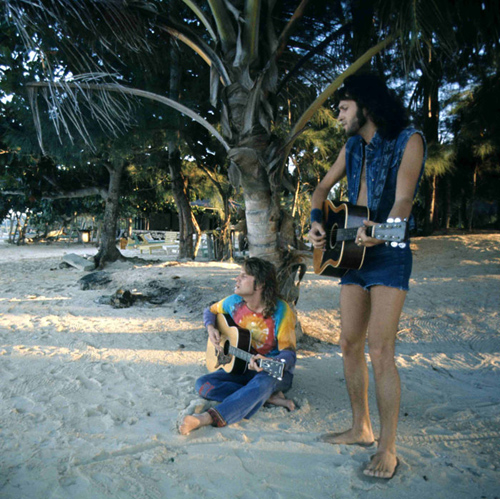
Next
on the agenda: a song writing holiday in Jamaica and then a
tour. Since Alvin Lee, is Ten Years After, where does that
leave his old band? He said: “I have certain commitments to
Ten Years After which I intend to complete. We’ll be making
an album early 1974, and we’ll be touring. I think it’s to
combine my work with the band and Mylon. We’ll work
something out.” “On The Road To Freedom” is successful
on several counts: It gives us Mylon’s superbly bluesy voice
and Alvin’s surprisingly delicate, restrained guitar work.
There’s
little doubt, as you listen to it, that it’s been a labour
of love.
Now
the last word goes to Mylon: “Heroin’s the sneakiest thing
in the world. You think you got it under control and then you
turn around and you’re hooked again. I’ve been clean two
years now, but only because Alvin’s stuck beside me. Says
he’s going to give me a medal when I’m clean for five.”
With such a friend it’s likely he’ll make it.
|
Hit Parader Magazine - April 1974
ALVIN
LEE – TEN YEARS AFTER
AN
APPRECIATION
Article
Written By Leonard Brown
Songs
and Stories Special Edition
One
day they’ll be writing about all of this excitement as a
“Golden Age of Music”. And it’s a fair bet that some
Toynbee of tomorrow will make his reputation by proving in
scholarly terms that Ten Years After was the most important,
and possibly the only durable and prototypical band of its
time.
Four
young musicians, that future historians will remark, about
whom a few facts have been preserved, and these largely the
work of an anonymous early chronicler who set them down in
that archaic form known as a “bio”. (Here there will be a
footnote, of course, stipulating that bio writers were less
concerned about their facts than with the rapturous style they
affected, the point of the bio apparently being to extol the
merits of its subject. It further seems that bio-writers were
paid to speak praises).
Having
qualified his source and offered a wink of caution, our
historian will then proceed to elaborate on his thesis with
juicy excesses of enthusiasm which would shame the most venal
bio writer amongst us. We can only be grateful that the
members of Ten Years After will never see his words, lest
their modesty be offended….
To
turn the page and take a peak – our special privilege here
– is a treat, however, for those who really dig Ten Years
After. What will this man of letters say? From the perspective
of time beyond, he will look back and report:
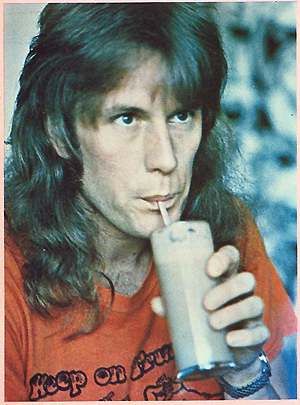 By
the year 1973, the band known as Ten Years After has emerged
from it’s formative cycle, uniquely intact and poised for
its greatest period which then lay ahead. The four, Alvin Lee
guitarist and vocalist; Leo Lyons, bassist; Chick Churchill,
organist, pianist; and Ric Lee, drummer, had (in the words of
the bio) “got Ten Years After together, had stayed together
and grown together”. Hence, if one cares to survey the
accelerated evolutionary course of pop music in what might be
called the post-Beatles era, the late 1960’s and early
1970’s, the most significant trends are epitomized by the
career of this outstanding group, Ten Years After. By
the year 1973, the band known as Ten Years After has emerged
from it’s formative cycle, uniquely intact and poised for
its greatest period which then lay ahead. The four, Alvin Lee
guitarist and vocalist; Leo Lyons, bassist; Chick Churchill,
organist, pianist; and Ric Lee, drummer, had (in the words of
the bio) “got Ten Years After together, had stayed together
and grown together”. Hence, if one cares to survey the
accelerated evolutionary course of pop music in what might be
called the post-Beatles era, the late 1960’s and early
1970’s, the most significant trends are epitomized by the
career of this outstanding group, Ten Years After.
Moreover,
one could see an increasing influence by Ten Years After upon
the direction of musical
change and development. The immense popularity of Ten
Years After, as
well as the musical innovations of the band’s members,
prompted other artists to raise their standards of performance,
so that the effect upon music generally was to stimulate
technical perfection and encourage artistic integrity.
There
follows a welter of footnotes, and a couple of these are
relevant. First, the two Lee’s of Ten Years After are not
related to each other: and a quote from an obscure source:
“Keyboardist Chick Churchill out-phrases and phases out the
memory of that other Churchill”. (Whoever he was.)
To
speak of the band in 1972, bringing “rock & roll music
to the World,” to quote the title of their most recent album
(Columba), is to praise a polished and matured Ten Years
After, at a point five years later. For Ten Years After was
fledged in 1967.
Before that year, Alvin Lee and Leo Lyons had worked together
in the provinces, in Hamburg and in London, a route similar to
that yellow brick road along which so many British musicians
had scuffled from subsistence to stardom.
Fortune’s
touch was on Lee. Some kids arrive with the silver spoon plus
a bowl to put it in, but Alvin was luckier. His father was a
collector of ethnic blues recordings, funky old 78’s,
and as a child Alvin heard little but the root-sack of
pop music at its best. Leadbelly, Big Bill Broonzy, Muddy
Waters, and the whole beloved roster of shouters and strummers
and mumble-ers, and tricky pickers. He couldn’t have had a
better prepping for his share of the action when blues later
seized it’s hour in British music of the mid 1960’s.
Another event was fortuitously timed to remake our music
historian’s chosen subject. In the mid-50’s, the Presley
tidal wave hit the shores of Blighty. Again, lucky Lee was at
the precise age to be impressionable, wide open to accept-and
later elaborate upon-the Elvis manifesto.
Leo
Lyons, like Lee, was from Nottingham, and for what it’s
worth, so were Robin Hood and his Merry Men. If Robin was as
near to spot on with his bow-and-arrow as Leo Lyon learned to
be with his bass, then all the stories are true. Leo Lyons,
-there’s nothing in the source material to indicate his
astrological sign, but he even looks leonine- was noted in his
pre-Ten Years After days as a fast –jamming bass player. His
preference for jazz fingering established him as a flexible
and resourceful equal player with the other members of the
group.
Our
scholar digresses to say that the majority of bass players
were a sad lot back then, made to stand out of the way and
play rhythm effects , “Whomp, whomp, lump, lump….” And
so on. However, Leo Lyons could play flashy riffs and
variations, which gave him a unique status amongst his peers.
If this seems to be a distortion of things as they are,
remember that our historian is reporting from the distant
future, and besides, it’s that there are far fewer great
bassists than there are guitarist. Further, it’s also true
that Lyons is incredibly quick and agile on an instrument
of very severe limitations. No questions, he’s one of
the great bassist of our times.
These
two, Alvin Lee and Leo Lyons, were joined by the other two,
Chick Churchill and Ric Lee in 1967. For a break, the band was
booked into London’s famed Marquee Club, which incubated
whole generations of British Rock Artists. Ten Years After was
playing blues, into the unswerving musical commitment which initially bucked the trends. “We would do an
occasional ballroom where we would die a death,” Leo Lyons
told a reporter in reminiscing about the bands first year.
They weren’t exactly a rich band , according to Leo, with
second hand equipment
and an old van to haul it in.
As
a house band at the Marquee, Ten Years After began to pick up
prestige and a following. Then came 1968, and the Windsor
Festival, an annual blues and jazz event. Ten Years After
played it collective heart out for 20,000 people. Then 20,000
people stood up and roared their approval of Ten Years After.
Stepping
Stones: Marquee Club and Windsor
Festival, recording contract , and their first album.
On the back of that first album is a picture of four very
serious young guys with Beatle haircuts. And shirts with
collars – Alvin Lee in a zipper jacket. Chick Churchill in a
leather jacket, looking straight at the camera, maybe hoping
someone will show up to pay for this so they can go free when
it’s over. Scared and just unbelievably wet behind the ears.
There
was some nonsense in the liner notes on the first album. John
C. Gee manager of the Marquee Club, wrote them. “I got to
know the group pretty well over these past few months, but
even so, the mystery about their past still persists. For
example, the organist Chick has no other name.” Well, what
would you do if you were a kid playing loud music and owning
the name? Leo Lyons was hyped as an ex-cowboy actor who played
in German produced Westerns. (Achtung, Herr Dillon...“)
And Gee
spoke of a ring in Ric’s ear, the mark of a very Bohemian
life! The “mystery” was, that there was no mystery, just
comfy British middleclass boys who had, for reasons only other
musicians could understand, chosen a trade which is tougher,
more competitive, and on the average, less rewarding than say,
had carrying.
Ric
Lee, for the record, was a woodshed disciple of Gene Krupa,
the innovator who first played drums as a solo instrument, and
a student of all that was good enough to be preserved on
shellac or acetate. He listened to the big bands – Buddy
Rich, Duke Ellington, Louis Bellson. Given an opening, he
would tell any interviewer of his dream to be a big band
drummer. He too cut his teeth on ethnic blues, but quickly
outgrew the simplicity of the older form. Today he is absorbed
by the complexities of Afro-Cuban percussion techniques, which
is a logical phase of his development, and of the dedicated
musicians quest for origins.
As
for Chick Churchill, he is that rarest bird of all, the rock
musician who can read and write music. He was a child prodigy,
and began coaxing classics out of the piano when he was a mere
five-year-old. Alvin Lee has spoken of Chick as being “the
best musician in the band”.
To
characterize Chick Churchill in a couple of words. He’s shy
in conversation, and laid-back in performance. Where Alvin Lee
is flashy, Churchill is quietly impressive. Leo Lyons works in
great bursts of energy, and Ric Lee plays clean, crisp sets.
Each of the four is visually as well as audibly distinctive,
each a different presence from the others.
But,
it was in terms of their total energy that Ten Years After
broke through to fame via the short and unforgettable excerpt
from their performance at Woodstock in the film of that name.
Woodstock was a stunning experience for Ten Years After, as it
was for all who played or listened during those fabled days
and nights of music. The picture? “I saw it. I saw the film,
and I couldn’t relate to that person up there doing that…..”
Alvin Lee saw Woodstock as a mixed blessing. An hour and a
half of hard and heavy jamming had preceeded the out of
context climatic performance of “I’m Going Home” which
had always been the Ten Years After wrapper-upper. Lee’s
sense of form was offended. To get the feel of Lee’s
attitude, you would have to experience a Ten Years After
concert. A Ten Years After concert is a faithful as a band can
be to the basic premise of all concerts. It gets the people
off by structuring the tensions of its program into an
ascending curve of excitement. It’s not unlike theatre,
having a beginning, a middle, a climax and a ending. As formal
as a corrida, as breath-taking as a sky dive- as surprising as
a new lover, Ten Years After puts the audience through changes
and turns in direct response to it’s high energy command. At
the right moment, they jam, and when the moment is intuitively
right again, they tie all the parts together into an
irresistible, tightly, executed spasm of musical fulfilment.
It’s orgasmic. No other word quite says it.
From
beginning to end, the suspense is in knowing what this amazing
band can do, but never exactly know, how it will all be
accomplished.
Historian
or biography writer
or sixteen year old at his or her first concert – all alike
have joined the great international tribe of Ten Years After
fans, because Ten Years After is just about the best there
is……
For
our future historian, these last few details……
Woodstock
thrust the band’s career into the super – dimension of
stardom and audiences screamed for “I’m Going Home” –
which Ten Years After stubbornly saved for last, as it always
had. The recording pace stepped up, and Alvin Lee, speaking
for the band’s feelings in the matter, described the
problems of the studio. They wanted live sounds on their
albums, but the live recordings which were released were never
wholly satisfactory by the bands criteria.
Until
“A Space In Time” Ten Years After seldom endorsed its own
product without reservations. (Their audience agreed – “A
Space In Time” became their first gold album).
When
they returned at last to the spotlight and the studio, they
were as they had been, four musicians doing what they wanted
to, in the way they wanted to do it. Nine albums, eight tours,
and an un-counter number of sets and sessions later, their
faces on the newest photographs are cool and confident and
unguarded. Times have changed. The music is always changing.
Ten Years After is part of a whole, affecting its art and its
times and moving surely with the motion of these currents,
occasionally returning to the small concert halls, in an
attempt to re-establish the intimate communication necessary
to make the emotional growth of their music relevant to their
audience.
Here that future historians will begin to tell us
what comes next, but we may have to wait a bit to see that
page.
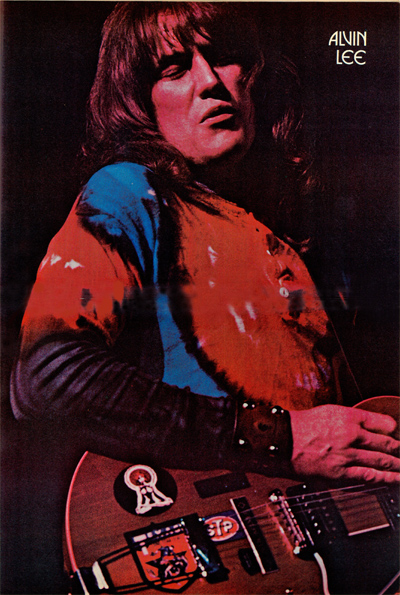
|
|
Rolling Stone - April 11, 1974
On The Road To Freedom
- Alvin
Lee and Mylon Le Fevre
Two
often unpersuasive musicians have combined to make an album better than
any of their past work. Alvin
Lee and Mylon LeFevre may have always been talented, but their performing
contexts did not
highlight
their strengths, each has released the other from the conventions in which
they both stagnated.
On
- On the Road to Freedom, we discover that Alvin Lee isn’t just a slick
blues guitarist and purveyor of boogie, and that Le Fevre can do more than spew out gospel
jive. The new
music doesn’t conform to any idiom
just
a general feeling of Southerness. The original material has a
self-scrutinizing aspect that is simply stated and credible.
Among the best are Lee’s “Fallen Angel,” “Carry My Load,”
and the title cut.
The
two non-originals are beauties. Ron Wood’s “Let em Say What They
Will” is a good-natured but hard-nosed
guitar rocker. George Harrison’s “So Sad” (No Love of His Own)” sounds to
me like one of his best songs. Both
writers
perform on the album. Le
Fevre and Lee sing with a virile dignity reminiscent of Eric Clapton’s
singing on Layla. They have my respect, and their
partnership is too mutually beneficial to be limited to a single album.
By
Bud Scoppa
|
|
New
Musical Expresss
From
April 20, 1974
Playing
In The Band by Rex Anderson
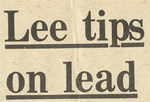
What
you do is, just before you leave the office you realize your
notebook’s full so you grab a few leaves of foolscap, fold
them in half and then fold them in half again so they fit in
your pocket. Then when you start to chat to Alvin you produce
same and start jotting things down on the first square. Then
you realise that Alvin is talking nineteen to the dozen and
the pen is flying to get everything down. You fumble about to
find another sheet. You leave very pleased with yourself
having gleaned a lot of information useful to guitarist who
want to follow in Alvin’s footsteps. Then with one thing and
another, you 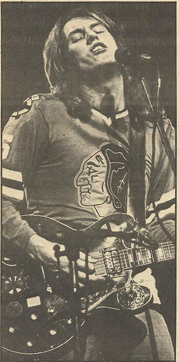 don’t bother to write
anything, because someone
else has already done something on him in the New Musical
Express anyway. Weeks after, like now, you realise there’s a
bit of a buzz about the band as set up for that solo concert
and rumours that despite his denials at the time Ten Years
After could possibly split, so perhaps that amazing Rainbow
concert will be the first of many. It’s then you drag that
makeshift notebook from the bottom of your satchel and realise
that your notes would make a good basis for a Waddington’s
word game. Anyway, this is how it all happened. Alvin was
planning the solo concert as a way of recording some
twenty-five songs he’d written, and he assembled a band that
included Ian Wallace on drums (who is left handed and plays
with the hi-hat on the right in case you ever get confused).
Tim Hinckley on piano, Mel Collins on sax, Alan Spenner on
bass plus the vocal powers of Frankie Wilson, Dyan Birch and
Paddy McHugh. The result was a tight funky sound that
degenerated into some great rock and roll and attracted an
audience that included Harrison, McCartney, Starr, Stewart and
others. don’t bother to write
anything, because someone
else has already done something on him in the New Musical
Express anyway. Weeks after, like now, you realise there’s a
bit of a buzz about the band as set up for that solo concert
and rumours that despite his denials at the time Ten Years
After could possibly split, so perhaps that amazing Rainbow
concert will be the first of many. It’s then you drag that
makeshift notebook from the bottom of your satchel and realise
that your notes would make a good basis for a Waddington’s
word game. Anyway, this is how it all happened. Alvin was
planning the solo concert as a way of recording some
twenty-five songs he’d written, and he assembled a band that
included Ian Wallace on drums (who is left handed and plays
with the hi-hat on the right in case you ever get confused).
Tim Hinckley on piano, Mel Collins on sax, Alan Spenner on
bass plus the vocal powers of Frankie Wilson, Dyan Birch and
Paddy McHugh. The result was a tight funky sound that
degenerated into some great rock and roll and attracted an
audience that included Harrison, McCartney, Starr, Stewart and
others.
Anyway,
as I was saying, at the time he had all this planned a few
very select journalist were invited to Alvin Lee’s country
estate out by Reading for a look at his private studio, a game
of snooker and a chat. Now Al is a big fella – at least nine
foot three and well built – and he scared the daylights out
of me, so I crept into a corner with my drink and chatted to
Ian Wallace until a former member of the New Musical Express
staff, now working as a part-time flunky, ushered me into the
great man’s presence.
As
it happens, Al turns out to be just about as scared of me as I
am of him and to cut a long story short, we became the best of
friends on about page three of my notes, half way down.
“My
dad used to collect records, 78’s blues, Big Bill Broonzy,
Muddy Waters, Mother used to strum a bit of guitar.”
He doesn’t really talk like that. This is direct from
my notes for the sake of accuracy. “She had a four-string
tenor. My brother played clarinet. That was the first thing I
tried. I took lessons for a year but I couldn’t get into
it.” So he took up guitar, spent a year learning the basic
chords and then started applying them to music. Like we all
did I guess. “I wanted to get involved in the music of that
time, which was Elvis and Bill Haley. Then the British blues
bands started up around, people like John Mayall and I found I
knew a lot about it because of my father’s
records. “I joined a local band as a rhythm guitarist,
and pinched all the lead guitarist’s licks. They were
playing Shadows stuff and Chuck Berry.”
 So
as I’m constantly plagued by people who write in and ask how
to play lead riffs, I asked Alvin if he knows the answer.
Should you learn to read music, for example? “I don’t
think reading music is the way to learn. If you read you play
notes, which is what music is, but you should really be
learning to play phrases.” Now this is true, and it had
never hit me before. Until you’re really good at playing and
reading, you don’t learn much from reading music except how
to read and a few difficult “stretches”. You don’t learn
to hear what you are playing or to listen really because music
becomes something visual. This is really good advice. Read
on… So
as I’m constantly plagued by people who write in and ask how
to play lead riffs, I asked Alvin if he knows the answer.
Should you learn to read music, for example? “I don’t
think reading music is the way to learn. If you read you play
notes, which is what music is, but you should really be
learning to play phrases.” Now this is true, and it had
never hit me before. Until you’re really good at playing and
reading, you don’t learn much from reading music except how
to read and a few difficult “stretches”. You don’t learn
to hear what you are playing or to listen really because music
becomes something visual. This is really good advice. Read
on…
“I
just used to listen to records so much that the phrases from
them were in my head. Listen until you can sing it, and then
copy it, and play round it. That way you can develop your own
style.” Now that really lays it on the line, and it helps me
too, because I’ve always been a rhythm player and want to be
a lead player. You may know your way round the guitar, or
organ or bass or whatever, but it’s no good just using your
manual dexterity in the hope that something good will appear
– because it won’t. There must be someone out there with
enough maths to compute the odds against hitting five random
notes that come out sounding melodic.
The
answer is to pinch some other lead guitarist’s riffs.

|
|
HARRISON
TOUR SET: „THEY’RE ALL HUSTLING HIM“ 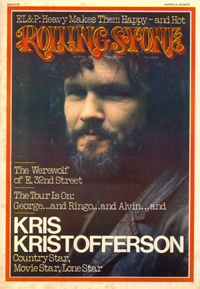
SAY’S
ALVIN LEE
From
Rolling Stone Magazine – April 25, 1974
London
– George Harrison is touring the United States this fall.
That much is certain. But that’s about all that’s certain.
Originally, reports out of Los Angeles early last month had
Harrison’s lawyers setting up a tour for September, with
plans for twenty five concerts in twelve to fifteen cities.
But the story, which leaked earlier than any tour principle
wished, and included a rumour that Harrison would be
accompanied by the reclusive Eric Clapton, generated a flurry
of denials.
Now
it appears the tour is on and that Harrison will most likely
be working with Ringo Starr, Alvin Lee (Leader of Ten Years
After, whose recent album with Mylon LeFevre featured Harrison
as guitarist) and drummer Jim Keltner, and Eric Clapton may
yet be involved.
The
newspaper reports took Clapton by surprise. Speaking from his
country home near Guildford, Surrey, Clapton told Rolling
Stone “My first reaction was, “What A Drag”. Then I
thought, “Well, it’s not such a bad idea”. After seeing
the news story, Clapton spoke with Harrison and was left
uncertain. “I can’t give you an instant denial, because it
might happen”.
He
said, “but it seems unlikely because of the way things are
planned”.
At
Apple Records in London, mean-time, A & R chief Tony King
was still trying to squelch talk about the tour as “anything
more substantial than speculation”. As late as March 25th,
King maintained that no decision on “booking or details of
musicians have ever been made”.
But
the man most likely to produce the tour Bill Graham said
otherwise.
Graham
as named in the original as the producer with the inside track
on the tour. But the appearance of the story, only a day after
Graham had returned to San Francisco from talks with
Harrison’s two attorneys in Hawaii, angered Harrison’s
London lawyer, who thought Graham leaked the story. Graham
denied it, but the Harrison representatives were reported
talking with other potential producers.
Reached
on March 22nd, Graham told us: “It’s at such a
state now, that I can’t comment. I just got back from five
days in London. Until it’s all spelled out, no comment”.
But you could almost hear the victorious smile over the
telephone. In London many of those around Harrison confirm
that he is set to tour. Having just returned from a two month
vacation in India, at the home of Ravi Shankar, Harrison minus
beard and looking understandably refreshed, is starting work
on a new album at the studios
built into his house at Friar Park.
Already
he has been swamped with offers from people wanting to be part
of his tour. “You should see the situation he’s in,”
said Alvin Lee. “Everyone wants to be involved, more people
than he could possibly work with. They are all hustling him.
It’s ridiculous”.
Still,
said Lee, “He wants to tour”. Even Tony King, the man in
charge of keeping the official Apple line polished, admitted
that Harrison seemed encouraged by what he had heard about the
Dylan tour (Produced by Bill Graham and his FM Productions).
RANDOM
NOTES
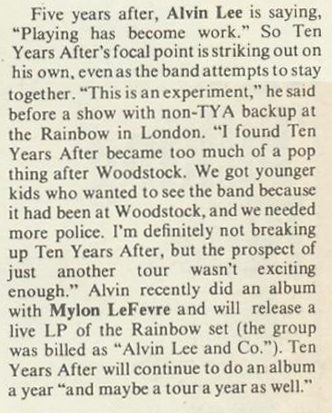
|
| New
Musical Express – April 27, 1974

Alvin & Mylon –
“So Sad” (Chrysalis)
Could it be the
“So Sad” I wrote many years hence, 1966 I think it was,
and for the Mersey’s?
No, it appears to
be one of those extended titles. It’s by a straight duo
known as Alvin and Mylon, who sound like a defunct 1950’s
duo who turned out surf music. In fact, it’s two very
close neighbours of Keith Moon’s Sherlock & Watson. Alvin
is, of course, the famous Alvin Lee of nearby Berkshire,
and Mylon is the Mylon Lefevre of Atlanta, Georgia.
The record? Some fairly George Harrison slide, from Alvin
and a nice vocal from Mylon. I’ve always liked Mylon’s voice, in fact he helped us out with some of the backing vocals, on the “Tommy” film. Most unfortunate, really, because we had to rub them out later on, due to a bad tape recorder overheating. This appears to be quite a mediocre song as I look at the label, I see it’s actually written by George Harrison. I think he’s done better in the past and I don’t know if this choice of song is a particularly good one. An interesting thing, that our George has produced a rather remarkable single, and which isn’t released yet: I have had the pleasure of hearing it, being in a certain rather In, “The In Crowd”. Just you wait folks, until you hear it for yourselves.
|
|
Melody
Maker - April 27, 1974

Ten
Years After
- Live
At The Rainbow Theatre
He
stands legs apart rocking backward and forwards on his
heels. The eyes are screwed tight shut, the shoulders
hunched,
the face contorted.
Below
him, charging lemming- like towards the stage come wave
after wave of bush-jacketed faithfuls:
Dancing
unsteadily in the aisles, rhythumlessly
clapping and stamping their plimsolls frantically
apeing his every
move.
Blistering
salvoes of notes come tearing through the darkness to
greet them, great grinding waves of riff rock.
Alvin
Lee is one of a seemingly-diminishing breed of guitar
super heroes. A note-bending. lick-swapping
master
of the high speed run, his fingers blurring on the frets.
Surely, you think, there must be a limit to the number
of
notes which can be crammed into any 12 bars? Well, if
there is, Alvin has yet to hear about it.
His
speed can be breathtaking. At London’s Rainbow Theatre
on Saturday his complete mastery of the
particular
subsonic facet of rock Ten Years After are into virtually
eclipsed the work of Leo Lyons, Ric Lee
and
Chick Churchill, and these three are no slouches
themselves when it comes to acceleration. Lyons
put in some spectacular bass work, Chick Churchill darted
around his keyboards and Ric Lee provided
an absolute air raid of a drum solo; but it remained Alvin’s
show.
At
the sound of the first note of the first lick a rumble of
warm familiarity would sweep round the theatre. TYA tried out a lot of new material, which was greeted
with considerable emotion, though whether
this
was due to its musical content or merely because it was
Ten Years After remains open to debate.
But
with the old favourites there could be no such doubt.
“Good
Morning Little School Girl”
brought the show to life after a quiet beginning
and “Walk Like A Man” (Love Like A Man) transformed
a fairly placid audience into a great jerking, shaking,
shuddering mob. And that mob was up on its
feet
and moving as soon as Alvin sent out the first driving
message of “I’m Going Home.”
The
rock n’ roll TYA pound out is often unremarkable. Indeed,
Alvin Lee’s voice is sometimes extremely
ordinary
. What puts them in a league above so many of the bands
who have followed in their wake, is
Lee’s
guitar and his Ferrarri-paced playing.
Earlier
Rococo had battled bravely to keep the crowd patient
before TYA came on.
Neat
and tidy in their music, they deserved a fairer hearing.
By
Kit Galer.
|
New Musical Express - April 27, 1974

Band
On The Run
- Ten
Years After / Rainbow
|
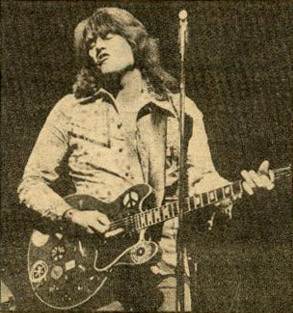 |
Ten
Years After just don’t cut the bread. I find it hard to
recall just when I heard a more boring, bored and
listless performance. Coming to prominence in 1966, TYA these days
are like the ancient family dog nobody
has
the heart to put down. As far as I’m concerned they’ve
had their day, and what they now present on stage
is
unexciting nostalgia, capitalising on what may have once
been a worthwhile contribution to rock. Significantly,
the only remark of any value that Alvin Lee uttered at
London’s Rainbow on Saturday was:
“Oh yeah, this is another new one (number) I keep
forgetting.
They all sound the same to me” I don’t think he was
joking,
because I was of the same opinion.
I
found his attitude insulting, for reasons other than that
comment. He took the stage centre, turned his axe upp
way
above the other instruments and stretched his artistic
capabilities as far as the width of the Strand,
when
we all know he has more talent than that. Anybody would
have thought he was there under
sufferance,
which may I suppose have been the case.
Their
act reached its nadir when Lee encapsulated all the old
Cream lick’s in one solo, and then de-tuned his guitar
and continued to play. Admittedly the audience response
was rarely short of ecstatic, and they
spasmodically
pumped their hands during the numbers in what appeared to
be attempts to relay adrenalin
to
three members of the band: Alvin and Ric Lee and (Chick
Churchill, Leo Lyons (on bass) alone
gave
an impression of sincerity and interest in what he was
doing.
For
me the only excitement of the whole night was when a top
hated gentleman kicked somebody out of his
seat
two rows forward. Which is odd considering TYA’s act is
obviously rocks-off orientated.
The
music including a couple of newies, like the reworking of
“Lucille” called “You’re Driving Me Crazy”
and
the earlier “Look Into My Life” was one monotonous
riff, with Lee barking vocals like a fairground
hustler
, then acting out his role as an inexcusably loud King
Khord. There were actually moments when
Churchill
had to physically hammer his keyboards like a set of
congas to be heard over the lashing six string.
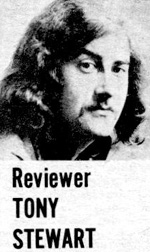 Competent
musicians TYA may be, entertainers they certainly are not.
Their stage presence was as flat as a
Woolworth’s
portrait reproduction. Alvin Lee’s delivery of notes at
an immense speed resembled a
production
line worker knocking rivets into a car body: precise
motions, but without any other purpose
than
holding something together until it’s time to go home. (I’m
Going Home that is)
Sorry,
but it was a relief when it was. Competent
musicians TYA may be, entertainers they certainly are not.
Their stage presence was as flat as a
Woolworth’s
portrait reproduction. Alvin Lee’s delivery of notes at
an immense speed resembled a
production
line worker knocking rivets into a car body: precise
motions, but without any other purpose
than
holding something together until it’s time to go home. (I’m
Going Home that is)
Sorry,
but it was a relief when it was.
By
Tony Stewart
|
CIAO 2001, 28 April 1974
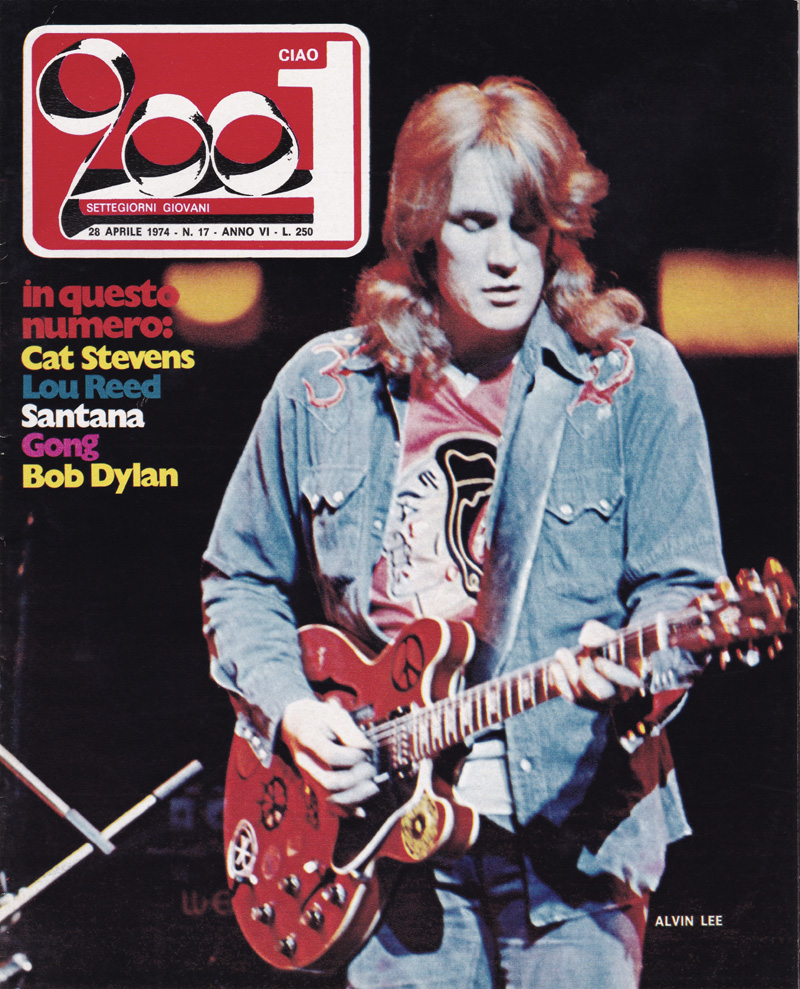
Alvin Lee at the Rainbow
Theatre, London


The famous Rainbow, temple of London rock, witnessed the
concert held by Alvin Lee without the Ten Years After. He was accompanied by Alan
Spencer, Neil Hubbard, Tim Hinckley, Ian Wallace and Mel
Collins. But something, according to those who attended
the session, did not go the right way. There was no
Alvin Lee on stage but someone who vaguely resembled
him. His ghost.

Many Thanks to Christoph Müller, Marcello Ecchia
and Alessandro Borri
|
The reviewer is a female,
Angela Pergolani, wife of the special envoy who is
based in London for CIAO 2001 magazine
Translation
kindly provided by Alessandro
Borri
I'm pretty worried today. In
an hour I have to be at the Rainbow to attend Alvin's
concert without his Ten Years After.
Big advertising and big
expectations.
I'm worried because I have to
leave my father at home who has to take down an
interview. Forget it. And here I am
running to the train station. A crazy race and the train
is also late. However I am facing the
Rainbow.
There's a lot of people in the
lobby ... rock people. Near the fountain a swarm of
squeaking girls.
At the centre of the agitation
no one else but Rod Stewart complete with a silver satin
scarf worn like a turban and a pair of super-tight pink
shocking trousers. All to go unnoticed naturally !
When I'm about to get close to
Rod my eyes are clashed with the glow of another group
of stars that is making its entrance to the Rainbow:
George Harrison Paul and Linda McCartney !
The evening at least at the
beginning is quite exciting. The hall of the Rainbow shines
with the light of great occasions: only the Bowie
entourage is missing.
There is to lose sight,
hearing and sleep .. but this does not matter to anyone.
Electricity passes through the bodies and frees itself
in fast gestures, in an excited shouting: they all
appear in "speed"
But let's go to the concert.
This is Alvin Lee's first concert with the new line-up,
which is the one he worked with in the studios ... the
voice that Ten Years After is leaving does not seem so
groundless.
The band that accompanies him
on this occasion is formed by Alan Spencer on bass
(perhaps one of the best there is). Neil Hubbard on
rhythm guitar, Tim Hinckley on piano, Ian Wallace on
drums (Tim and Ian are former King Crimson) and Mel
Collins on Sax.
Not bad for a band !
All elements that at the
individual level of instrumentalists are among the most
interesting of British soul rock.
Something great is expected:
one of those concerts that remain in your brain for
years to come. Superman super session.
Like the result obtained by
Mike Bloomfield, Al Kooper and Stephen Stills in that 33
rpm remained historical called precisely "Supersession".
The Rainbow is packed in all
its capacity which is around 3000 seats.
I find myself sitting in the
stalls in the fifth row together with those I believe
are from the local press ... They all have a face like
old foxes of business.
But here is the band... Alvin
Lee in the front row, dressed exactly like on the cover
of his 33 rpm made with Mylon Le Fevre, or jeans and
jeans shirt with patch on the knee.
The applause is very long.
Alvin seems rather nervous to me, I understand that for
him it must be a special occasion, a kind of test bench
for himself and for the band behind him: maybe a test to
see if without Ten Tears After ... I notice that even
the other members are nervous, they keep smiling to the
public and seem uncertain whether to start or not ...
The concert kicks off with
"Life's Trials" a song that sees Alvin on acoustic
guitar. The song seems appropriate: the title seems to
fit the situation.
I am focusing on the piece but
I cannot perceive nothing but an attempt, a musical
attempt of a band that does not seem to have found the
right harmony and the right way.
It's just the beginning, I say
to myself, you have to be too critical, the audience at
Rainbow would upset a veteran
Isn't that what happened to
Stevie Wonder the first night?
Then it is Alan Spencer who
takes the microphone with "Down Home Mama", an old
Grease Band song. the impression is that Alan on the
bass works very well but leaves something to be desired.
Honestly, I must say, I start to get bored.
Alvin's guitar rarely reaches
the heights of certain Ten Years After concerts. Perhaps
the thing is wanted. Perhaps he wants to give the
impression that everyone in the group has the same
importance.
It seems as if everyone was
"braking": everyone in the room seems to be waiting for
the explosion but the latter has no intention of seeing
it. So it is also for a couple of completely new pieces
whose titles I missed ...
The band should potentially be
able to give excellent things but in reality it is only
giving me a great disillusionment and a great desire to
go out of the range. The show resumes with "Step Back"
and with the audience that starts loudly to invoke
Alvin's old hits.
Nothing to do, the concert is
turning into a monotonous succession of known sounds, of
sounds that have little to do with the "sacred fire" of
creation ...
Giancarlo under the stage
continues undaunted taking pictures of what now seems to
be the ghost of Alvin lee, the ghost of that 'Alvin that
one evening four years ago I went to listen to the
Lyceum in a fiery evening.
The vocal group formed by
Frankie Wilson, Dyan Birch and Paddy McHugh is not bad
but it also seems to get lost in this sea of nonsense.
The concert is coming to an
end, however, not before Alvin has made his
personification of Elvis Presley with "Don’t Be Cruel".
This becomes tragicomic. I no
longer resist being black with anger and I believe that
there are at least 2000 people in the room who are
thinking like me. An evening to forget. There was no
Alvin Lee on stage, there was no Alan Spencer, Neil
Hubbard, Tim Hinckley, Ian Wallace, Mel Collins on
stage, but someone who vaguely resembled them, someone
who had taken their place at night.
|
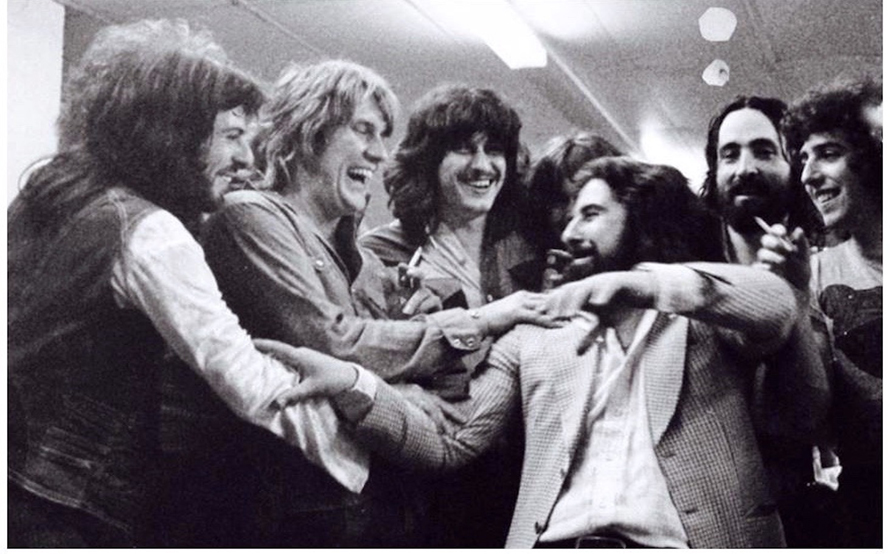
Alvin Lee and Ric Lee with PFM
Premiata Forneria Marconi - April or May 1974 |
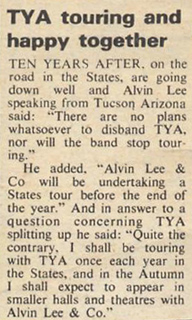
|
Ten
Years After – Positive Vibrations
From
Billboard Magazine – May 4, 1974
The
first offering from the group in some time, the album proves
well worth the wait. Opening selections are smooth and well
conceived, with that laid back rock feeling. Further on,
heavier rock numbers surface and the combination provides a
rich format for the group’s abilities. Mix and arrangements
are excellent throughout.
Best
Cuts: Positive Vibrations – Stone Me – I Wanted To Boogie
and Look Me Straight Into The Eyes.
Dealers: Proven sellers, and group’s followers
should be anxious to pick this one up.
|
POP Magazine - Ten
Years After "Positive Vibrations" Review

- Contribution by Marcel Aeby
-

1974 - TYA "Positive Vibrations" album
- Review by Janis Schacht for Circus Magazine (incomplete)
Alvin Lee 1974 - Positive
Vibrations Tour

|
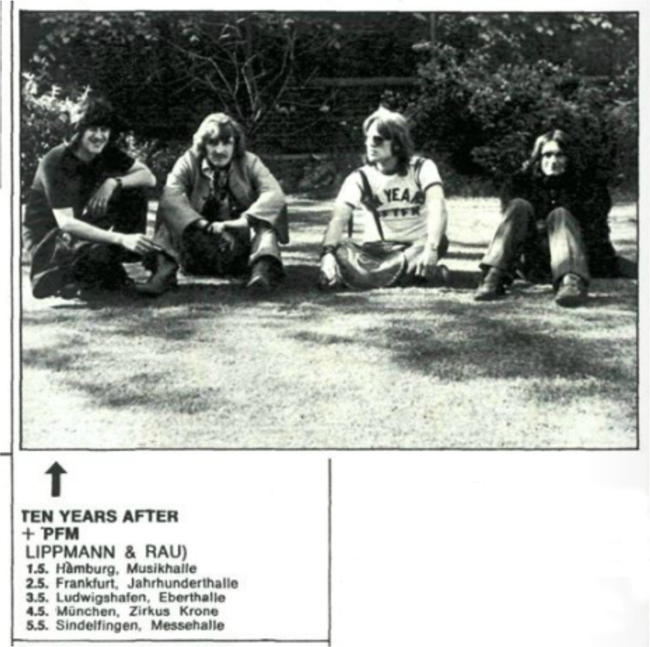
Our Thanks to John
Tsagas for this contribution! |

BRAVO
MAGAZINE
May
2, 1974
Zum Letzten Mal Mit Alvin
Lee?
|

|
|
Ten Years After beginnen in
diesen Tagen ihre Deutschland – Tournee
Hier könnt ihr Ten Years After sehen:
1. Mai – Hamburg, Musikhalle, 20Uhr
2. Mai – Frankfurt, Jahrhunderthalle,
20 Uhr
3. Mai – Ludwigshafen, Friedrich –
Ebert- Halle 20 Uhr
4. Mai – München, Circus Krone, 20 Uhr
5. Mai – Sindelfingen, Messehalle, 20
Uhr
|
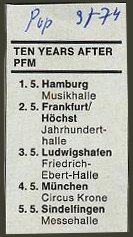
|
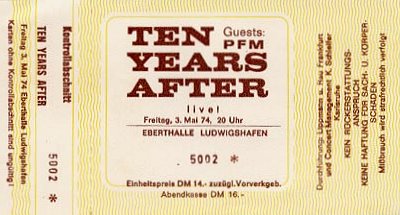

“Choo – Choo – Mama” fordern die
Zuschauer im Londoner Rock Tempel Rainbow in Sprechchören. So
heißt der Song, den 3,000 Fans an diesem Abend von Ten Years
After Boss und Sänger
Alvin Lee bei seinem ersten Solo – Concert hören wollen.
Aber Alvin schaltet
auf stur, „Ten Years After – wer ist das?“ ruft er ins
Publikum zurück. Seit sieben Jahren spielt er mit Ten Years
After zusammen. Gemeinsam mit Bassist Leo Lyons gründete er
die Gruppe. Mit ihr erlebte er die schönsten und
erfolgreichsten Stunden seiner Karriere. Aber jetzt ist er
dabei, die Brücken zur Vergangenheit abzubrechen – so wie
man Blätter aus einem Tagebuch einfach herausreißt und
fortwirft. Trennungsgerüchte gibt es bei Ten Years After
bereits seit zwei Jahren. Aber ein Konzert im letzten August
im Londoner Alexandra Palace brachte die Versöhnung und
schweißte die Band noch einmal zusammen. Oder war es nur ein
kurzer Burgfrieden? Mit
seiner Solo – Lp „On the Road to Freedom“ grub Alvin das
Kriegsbeil wieder aus. Und am 22. März zeigte Alvin Lee
seinen Freunden, wie weit er zu gehen bereit ist. Wie eine
Bombe platzte die Nachricht von seinem Solokonzert in den
Londoner Pop – Frühling. Mehr noch: Alvin hatte sich für
dieses Konzert eine Supergruppe zusammengestellt, die durchaus
in der Lage ist, Ten Years After in den Schatten zu stellen.

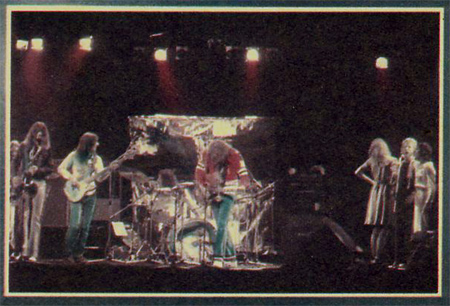
Bassist Alan Spenner und Gitarrist Heil
Hubbard stammen von der „Grease Band“, Pianist Tim Hinkley
von „Vinegar Joe“ und Mel Collins und Ian Wallace sind
Ex–Mitglieder von „King Crimson“. Dazu gehört ein dreiköpfiger
Chor. Fast 50,000 Mark hatte Alvin in dieses Konzert
investiert. Er sang nur neue Songs
- vom Jazz über Blues bis zum Rock. Stunden dauerte
die Show, die mitgeschnitten wurde und als Live – LP veröffentlicht
werden soll.
Den
Höhepunkt erreichte sie am Schluss, als Alvin vom
Beatles-Song „ Slow Down“ bis zu Elvis „Don’t Be Cruel“
mit alten Rocksongs die Fans aufputschte.
„Das Konzert hat bewiesen, dass ich auch allein
meinen Weg gehen kann“, sagt Alvin. „Vielleicht wird
unsere Deutschland – Tournee im Mai die letzte sein, die ich
gemeinsam mit Ten Years After unternehme. Für den Sommer
plane ich jedenfalls schon eine Tournee mit meinen neuen
Freunden. Was ich endgültig mache, entscheidet sich in den nächsten
Wochen. Da werde ich über meinen neuen Manager noch einmal
mit Ten Years After verhandeln.“
Written
by - K.E. Siegfried
Photos
by – C. Kranz
Note:
This was the transition period, between Alvin’s split with
Ten Years After and the start of his solo career
|
1974 May 5, Sindelfingen
Many Thanks to Edward Klenk for the following
contributions
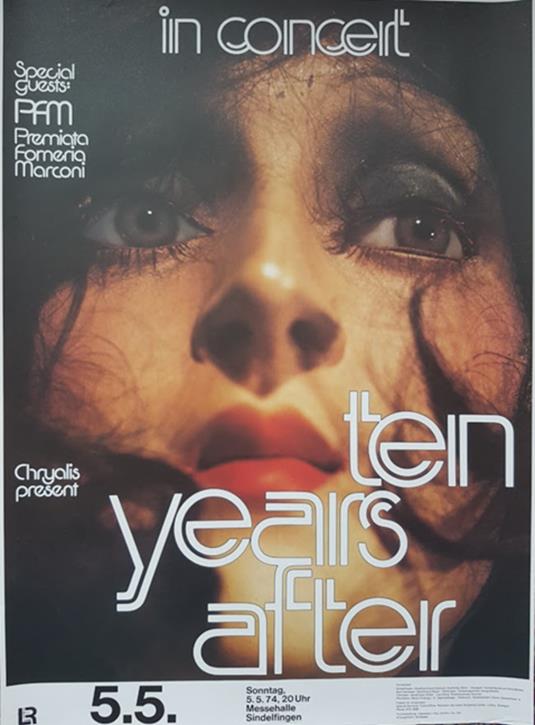



|
7
May 1974 at "Palais des Sports", Paris


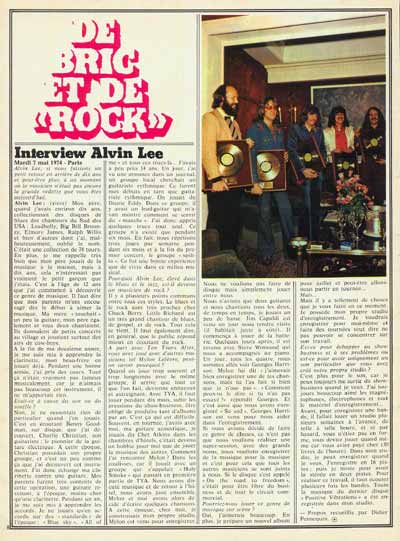
Click here for the PDF file
DE BRIC ET DE "ROCK" - French Interview
Thanks to John Tsagas (Greece) for
this rare contribution
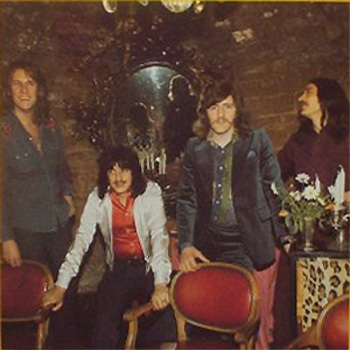

Palais des Sport
Paris, France 101 - Ten Years After In Concert May 7, 1974
Set List : Rock and
Roll Music To The World – Nowhere To Run – Good Morning Little
School Girl – It’s Getting Harder – Hobbit – Love Like A Man –
Slow Blues In C -
Look Me Straight Into The Eyes – Classical Thing – Scat Thing
– I Can’t Keep From Crying Sometimes – Silly Thing – I’m Going
Home – Sweet Little Sixteen
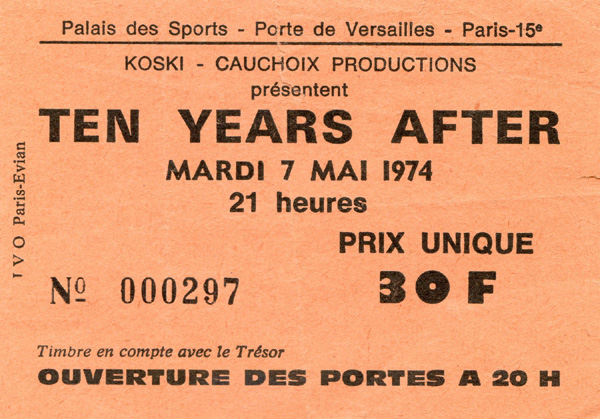
|
|
New
Musical Express - May 11, 1974

Ten
Years After -
“Positive
Vibrations”

Ten
Years After nowadays resemble a one time football
international who’s sadly playing out- his final-days
in
the Southern League and hoping to hang on for another
season. This album confirms the impression, that they’re
on a course of turning out colourless, anaemic boogie-ing
until their day finally comes.
Alvin
Lee never seems very interested in the proceedings and
since his efforts dominate the album it’s
rather
knocked on the head from the start. His guitar rambles
tamely through a collection of unremarkable songs
that too often feature lyrics that are coy and clichéd as
well as dated in the most embarrassing way.
“Can’t
Explain / Feel no pain / feeling so stoned / just keep
goin’ on / and I don’t give a damn / ‘cos I am what
I am
…..I
mean what’s it all about?

On
the positive side there does seem to have been an effort
made to present a softer, more considered TYA
compared
with previous albums. It lacks
much of the usual flash and thunder and
occasionally the band does
groove
together in a desultory fashion. That’s how it is on
“It’s Getting Harder” with a neat rhythm, clipped
drumming
from Ric Lee and chunky brass playing (probably from Mel
Collins, though he’s not credited).
Little
Richard’s “Going Back To Birmingham” is put down
much as the original with Lee’s guitar taking the piano
Line.
At least it moves. “Nowhere To Run” and “Your
Driving Me Crazy” are standard TYA boogie while
Chick
Churchill takes his one obligatory keyboard solo on
“Look Me Straight Into The Eyes”. The closing
number
“I Wanted To Boogie” is self-explanatory.
Otherwise
tracks like “Without You” are so tepid they’re
almost painful to listen to. It’s hard to credit
such
total blandness from what was once a great rock band.
That’s the saddest part about it really.
TYA
seem to have fallen into a false security through the
devotion of their many remaining fans. However,
none of the band are as talent less as they appear here.
I
think Alvin should end it now.
By
James Johnson
|

Will TYA stay together or split? Fans are
concerned after disappointing tour in May
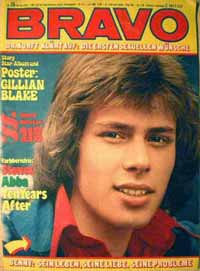
BRAVO No. 26 - 1974
1974 May - French Magazine
rock & folk
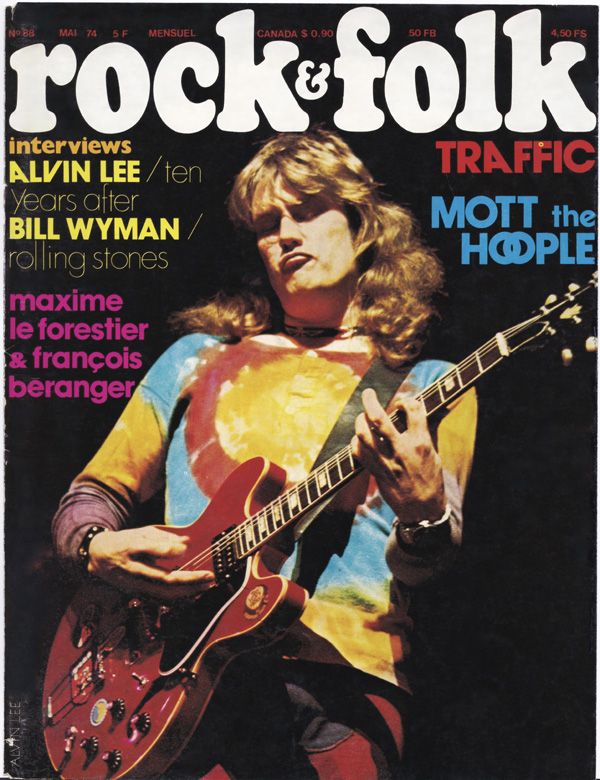
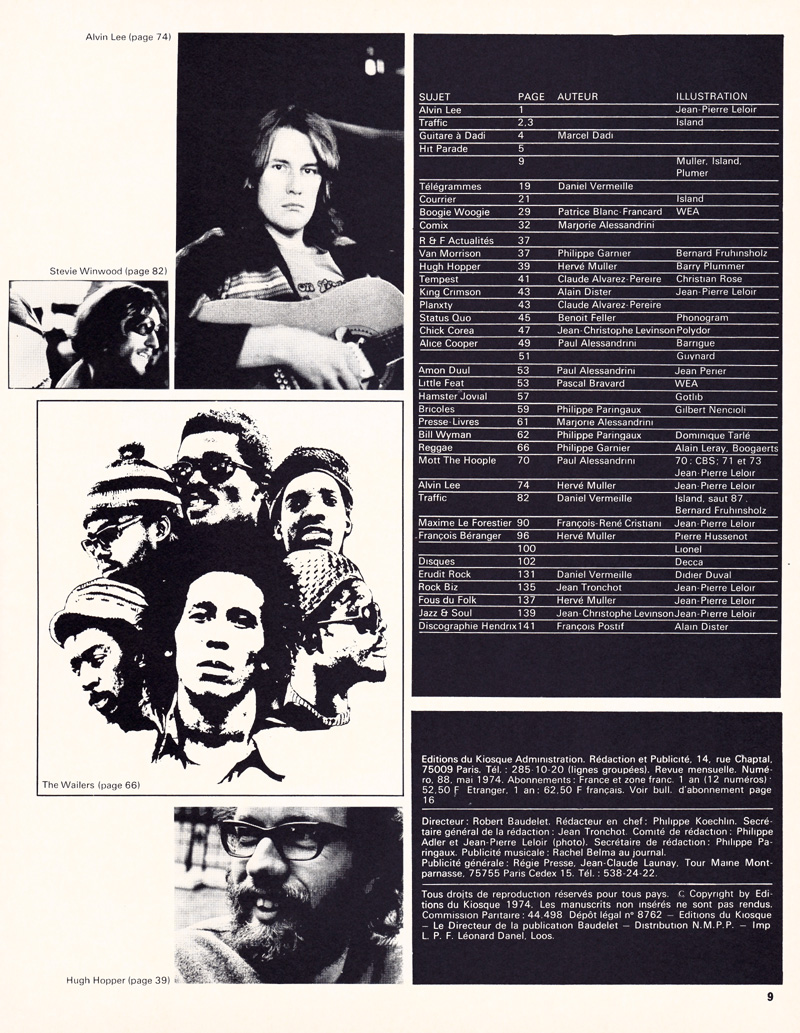

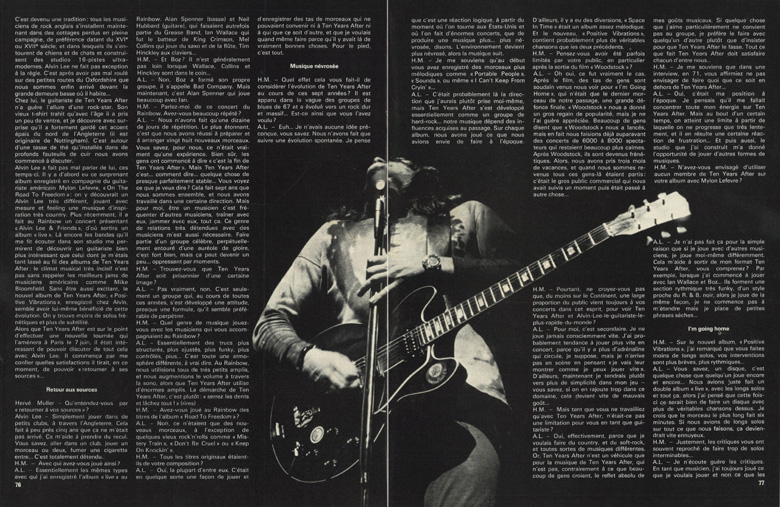
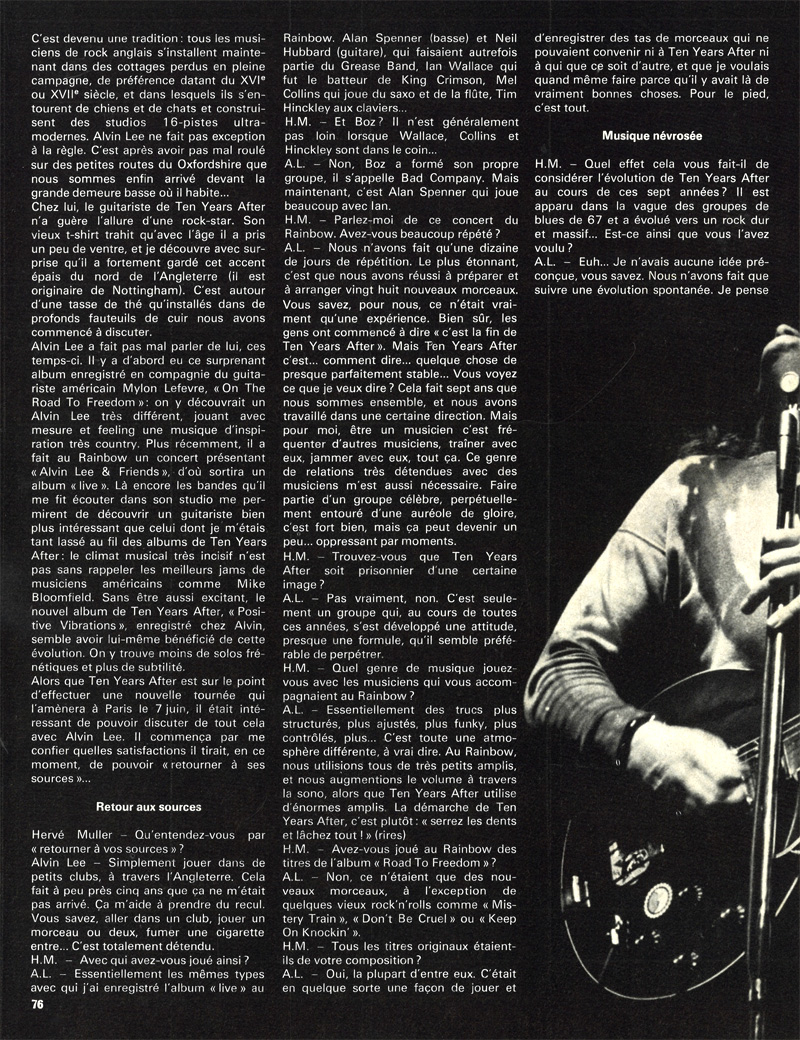
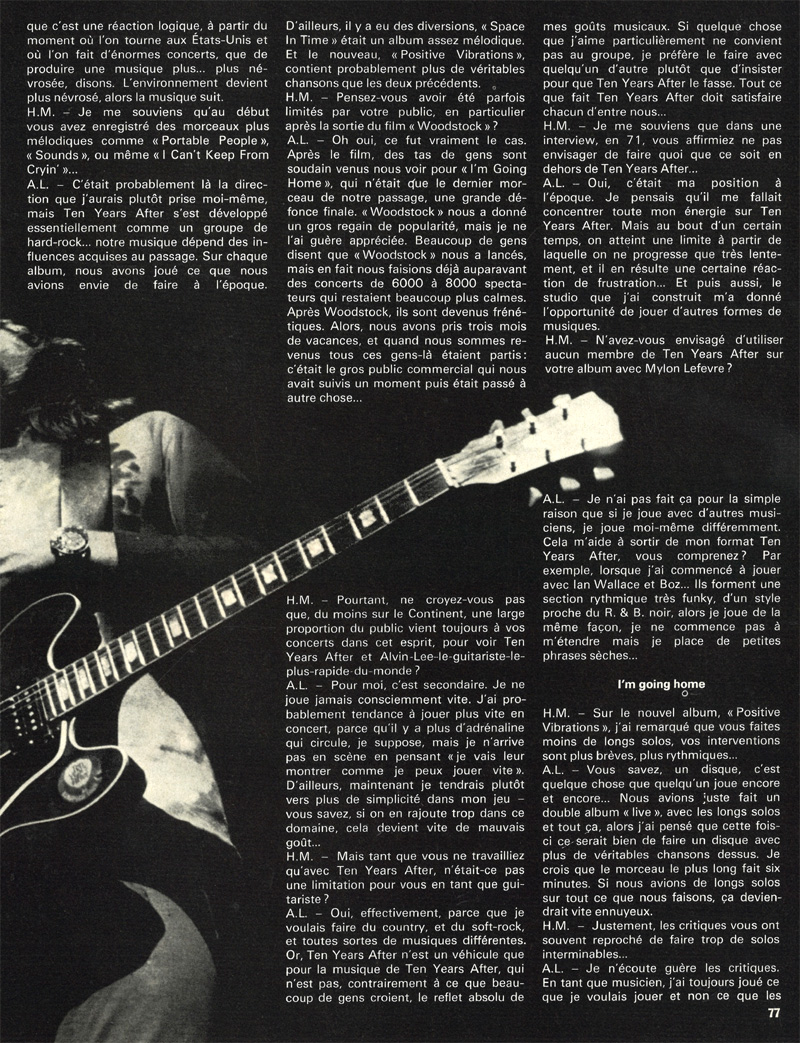

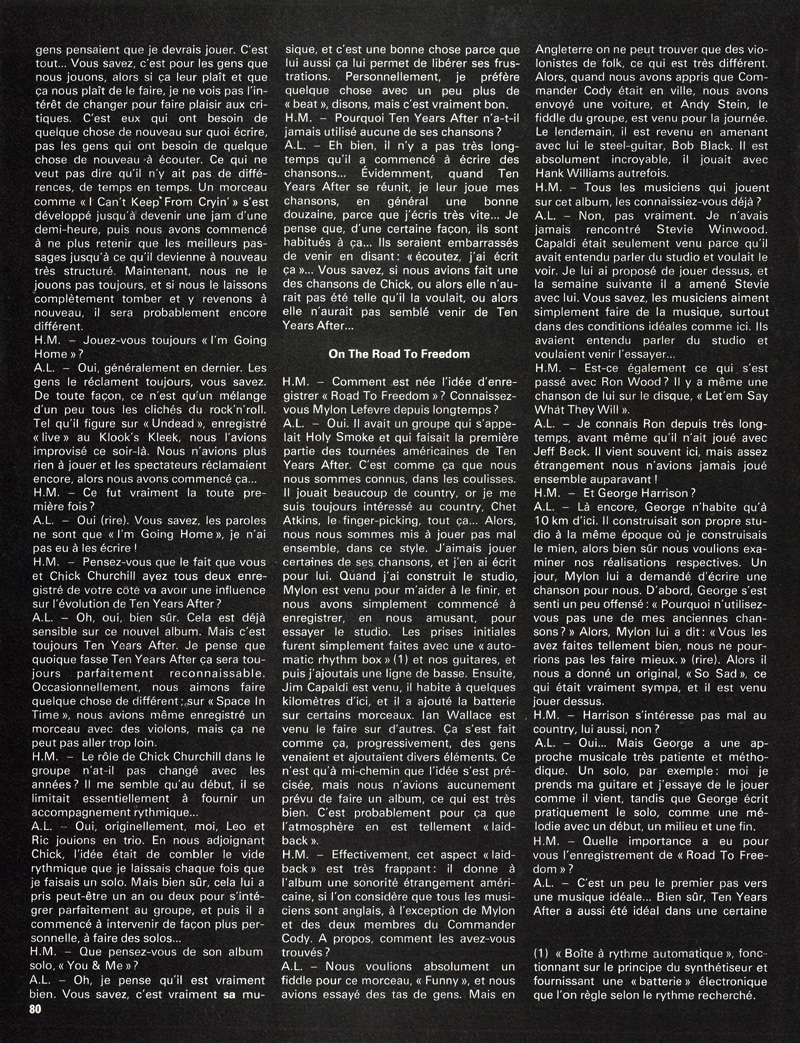

page 81 - (Photo: Jean-Pierre Leloir,
29, January 1973, LÒlympia, Paris)
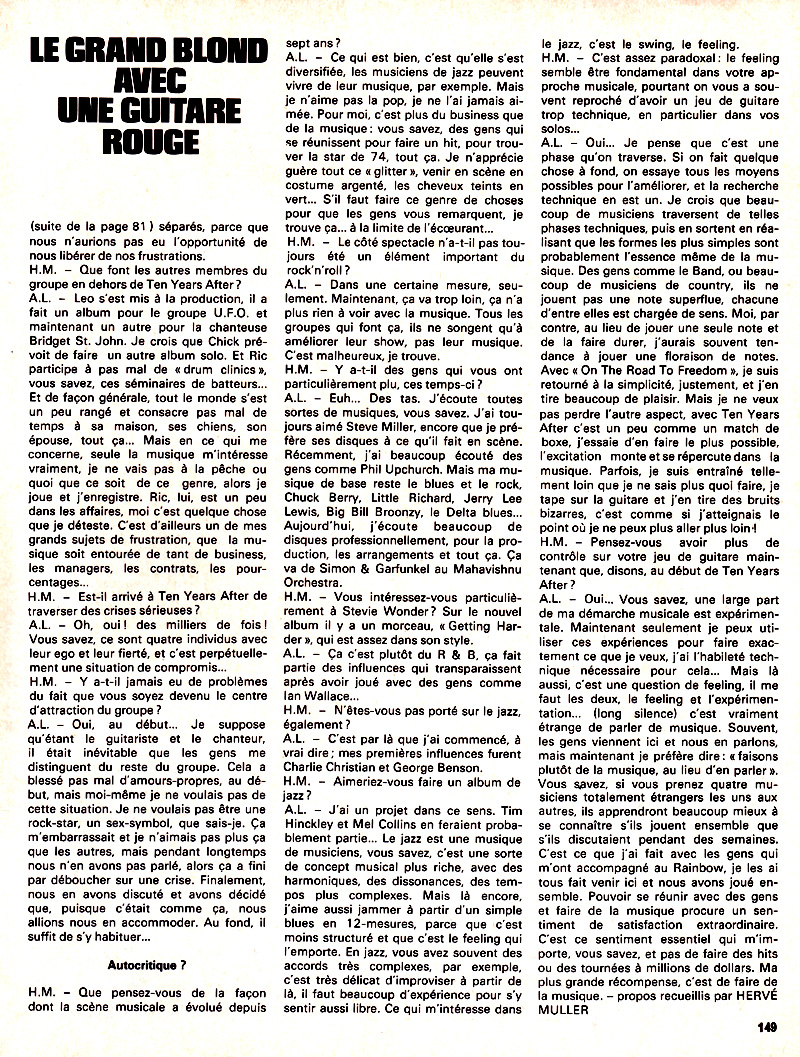
28 March 1974 - POP
Magazine, Germany
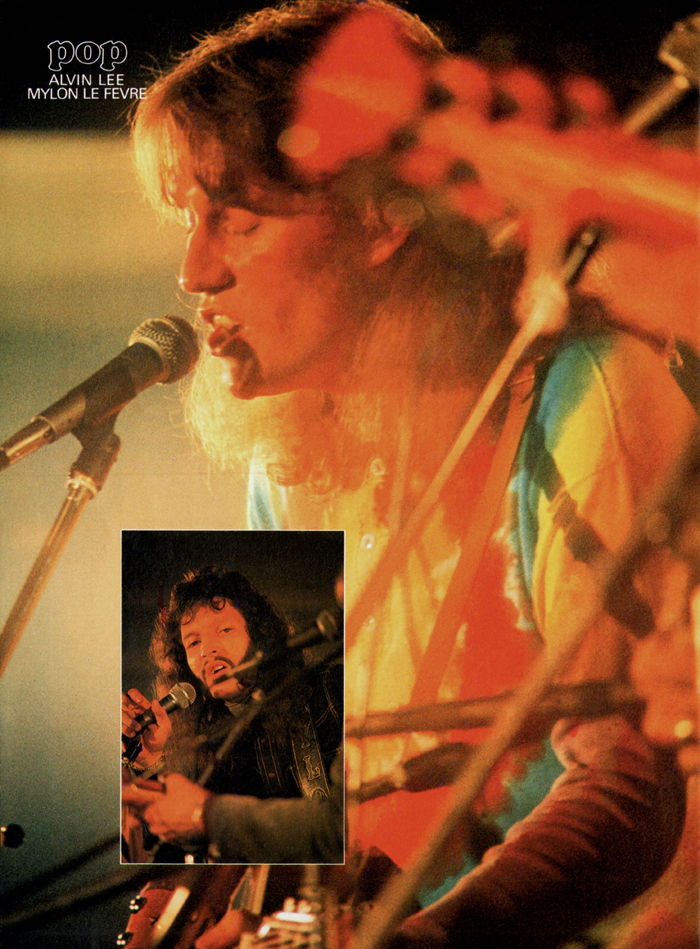

May 17, 1974 - Alvin Lee and Ten Years
After at Spectrum, Philadelphia
Photo by Paul Kasko
Contribution by Christoph
Müller
|
Record Mirror – May 18, 1974
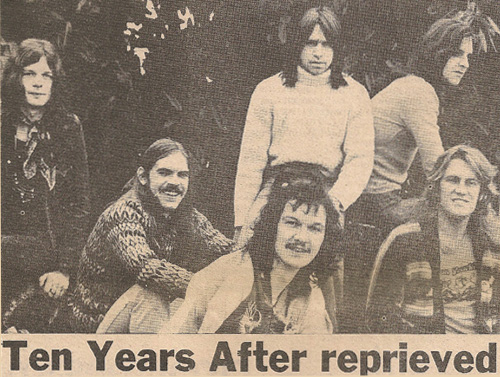
Ten Years After
Reprieved
Ten Years After –
“Positive Vibrations” album review
Well, after
putting down Ten Years After recently for a very boring
live performance at the Rainbow Theatre, I’m glad to admit
that they deserve some reprieve for this album. It
justifies my little faith in them and should put down the
critics who’ve suggested in the past that they died a
death musically after Woodstock. The first side of the new
album is quite amazing with so many different themes from
the aggressive “Nowhere To Run”, an authentic rocker,
“Going Back To
Birmingham”, the subtle title track “Positive Vibrations”
and “Stone Me”,
this track can
only be summed up by its title, laid back with Alvin Lee
effortlessly drawling through his lethargic vocal style.
Chick Churchill is prominent on piano throughout the
entire first side and comes through strongly, particularly
on “Positive Vibrations”. The second side starts with the
more familiar Ten Years After style on “It’s Getting
Harder” with Alvin adding the sharp, lightening lead
touches and Leo Lyons pushing an extremely funky bass
line, but I can’t really understand the inclusion of
“You’re Driving Me Crazy”, which sounds like a carbon copy
of the rocker on the first side. Also, the first few
chords of “Look Into My Life” sounds awfully like the
beginning of the Good Morning Little Schoolgirl song from
the earlier Ten Year After days and it’s a repetitive line
throughout the song. On the whole,
Positive
Vibrations should do very well, because it’s a “grow on
you” album, although I liked the songs the first time
around. The band all pull together with surprising
enthusiasm, but I only hope that some of it will rub off
on their future stage acts.
Article by J.B. |
|
GUITAR:
The
Magazine For All Guitarist
From
May 1974 – Volume 2 Number 10
 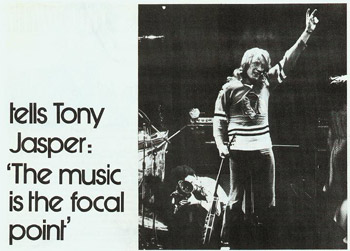
Tony
Jasper – Introduction:
Alvin
Lee first hit the music scene in 1967 when a new and untried
group called Ten Years After stole the thunder at the National
Jazz and Blues Festival at Windsor. Since then, Ten Years
After have sold millions of records and toured the States
eighteen times; they were one of the featured groups at
Woodstock in 1969. This March, Alvin took an independent step
with an album on Chrysalis “On The Road To Freedom”, in
partnership with Mylon LeFevre, and a Rainbow gig with a band
called Alvin Lee & Company. But he insist
that Ten Years After is not breaking up: he just wants
to further his musical interest, which encompass more than
rock and roll and blues. He says he is first and foremost a
musician, and consequently loves the guitar. I asked him when
he first took up the instrument.
Alvin
Lee: I picked one up when I was two! My mother used to
play a four-string tenor guitar. When I was twelve I decided I
must play an instrument properly. Actually I started on the
clarinet; my brother in-law played one. I had some lessons and
my interest lasted for about a year: it made me listen to
Benny Goodman and so to Charlie Christian, Christian is still
one of my favourite guitarist.
Tony
Jasper: So
you started playing guitar?
Alvin
Lee: Yeah, I started having lessons when I was thirteen;
one year later I played in public with a local band called
“The Jailbreakers”. I played rhythm first, and picked up
lead lines from the lead guitarist in the group. I had heard a
lot of blues because my father had a large record collection
of that kind of music. But all that had nothing to do with the
guitar music I was playing.
Tony
Jasper: What
were you learning on guitar?
Alvin
Lee: The chord lessons I had were kind of
“Sweet Georgia Brown”, “All of Me” and “A
Nightingale Sang in Berkeley Square”! I bought jazz records
by Kessel – in fact, all the guitarist of that era. After I
had learned the basics and adapted the guitar to making the
music I liked, I became a big Scotty Moore fan. I played a lot
of country-ish material, and this got me into jazz. I went
through a country picking phase and a jazz picking phase.
My
rock and roll phase started with Chuck Berry: I like his feel
very much, he’s one of my all time favourites. That’s
basically where my style came out of. Much later I discovered
George Benson. He’s one of the few who started out as a rock
and roll guitarist and went on to jazz.
Quite
a lot of jazz guitarist go the other way. I find moving from
rock to jazz very interesting:
You’ve
got the feel and then you develop your technique and go
further. Whereas once you’ve got the technique, it’s
difficult to develop feel. I’ve never read music, and I
don’t think it’s a good thing. In most cases it doesn’t
encourage you to extemporise and form your own style. I never
did want to read music. I didn’t sit down playing tunes or
songs: I sat down and played, and saw what came out, and found
sounds I liked and remembered. After a while it develops into
your own style.
Tony
Jasper: How
long did you practice?
Alvin
Lee: I used to do at least four hours a day, sometimes
more. Now I tootle around a lot. I play a lot of acoustic.
Tony
Jasper: What
guitars have you collected?
Alvin
Lee: There are quite a few! My stage guitar is a Gibson
ES-335. I’ve done a bit to that: I’ve taken the covers
off, and put a Fender back pick-up in the middle, so it sounds
like a Fender and like a Gibson. That’s great – I don’t
have to swap over! I’ve
also got an ordinary 335 without that extra pick-up. It’s
about fifteen years old. They don’t make them as good as
that now.
Tony
Jasper: What
have you done to that, anything?
Alvin
Lee: Everything! It’s got a different neck on it. All
it’s still got is the basic body. I’ve done all the
pick-up changes, rewired it inside. I’ve got a stereo Gibson
too, but I don’t use it a lot. Stereo is a bit fidgety –
there are too many things to muck around with. With a stage
guitar I just like to use the front pick-up or both: there’s
enough variation there without having to go to a six-position
switch. In the studio I use a Martin acoustic, a metal Dobro,
a Yamaha acoustic and a Yamaha nylon-string, two Ovations, one
nylon, one steel-string. And an old Gibson Melody Maker which
has a really good tone. If I see an old Martin in a guitar
shop, I buy it. You can do things with it because the basic
body is there. Nowadays they’re much lighter. The old ones
were heavy.
Tony
Jasper: Let’s
talk about you and Ten Years After. How do you find the
musical relation?
Alvin
Lee: Well, it has to be done where they don’t tell me
what to play and I don’t tell them. If we play a number and
one of us doesn’t like it, then it’s unsuitable. I mean,
I’m doing my own thing my way at present. I like a lot of
country stuff, for instance, while Leo likes something more
meaty.
Tony
Jasper: If
you could choose to jam with a group, who would it be?
Alvin
Lee: JJ Cale. I love the feel. You know, I’ve been
through practically every kind of guitar, even classical and
Spanish. I like to adapt and play with all kinds of musicians.
As far as rock goes, Ten Years After are a great band.
Tony Jasper: Some
rock guitarists have named the Rolling Stones as one band they
would like to belong with…
Alvin
Lee: I’ve never thought of the Stones as much of a group,
as a musical group. They’re more of an image than a sound. I
don’t know…I mean…No, I won’t knock the Stones.
Tony
Jasper: Well,
who impresses you on the current scene?
Alvin
Lee: Steve Miller. I’ve got all of his albums. Then
I’ve been getting into the
Mahavishnu Orchestra
and Chick Corea. Really, I can get enjoyment out of
anything, but then I like playing. Anything I can do to learn
more licks and more feel, then it’s obviously a help. I
listen to simply anything I can do in the jazz field. On the
other hand, at the moment the people in my band – that’s
“Alvin Lee & Company” – have been turning me on to
some
R & B, Phil Upchurch, a lot of stuff I once missed out on.
I love its simplicity. I think all artists go through a phase
of doing their utmost and then return to find the essence of
being simple. A simple guitar lick, just a couple of notes,
but it sits and fits right. Like a hemi-demi-semi-quaver run
is all very clever, but often it can be tasteless: it’s a
question of fitting it in rather than letting it come. You
have to have the feel – a matter where every note counts
without overstating. Like the Band. I really enjoy listening
to them: they don’t put an extra note in unless it’s
needed. Very tasteful.
Tony
Jasper: Yes, their lovely laid back feel is very
American, lots of ease, seeming to go with the country.
Alvin
Lee: Well, most of this music was American in origin –
blues and jazz. English forms have developed, but I think from
American origins. English folk seems about the only pure
English music.
Tony
Jasper: How
do you like your audiences to react?
Alvin
Lee: I’ve always enjoyed “listening audiences” (audiences
that listen), but you take them as they come. In the end you
don’t have any control if you play in public. I play my best
to come over, but I play better if I feel they are with me.
Then again, I like them to jump around a bit. I mean, you can
play quiet and people listen, play loud and let them jig –
you have that kind of control. Ten Years After don’t need
gimmicks. The music is the focal point. I don’t want to be
involved in the entertainment side, jokes and all that.
If
you want to improve as a band, it should start with the music.
So many bands are out on the road with thousands of
pounds-worth of props, trucks, their own stages, fifty roadies…Somehow,
current music seems less musical to me. What’s coming out of
Britain, I wonder? What’s Gary Glitter all about? Years
back, bands associated with the music; they were into that. A
lot of newer bands move in vogues and trends and keeping the
kids happy.
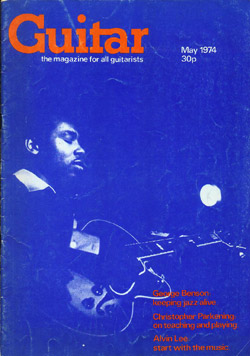
Tony Jasper: Do
you see quadrophonic sound offering anything?
Alvin
Lee – Reply: I don’t see it affecting our music. We
mixed a quad album with “A Space In Time”. To my mind
it’s not much better than stereo, just a bit more
complicated. On a live record, you can have more effects, but
basically I prefer to mix live in mono. You have such a wide
speaker set-up and many miss the stereo mix. To give everyone
a reasonable listen, then mix in mono.
Tony
Jasper: Finally,
let’s imagine you’re throwing a feast: who from the guitar
world – dead or alive – would be sitting at your table?
Alvin
Lee: A meal of guitarist? Sounds delicious. Dead or Alive?
Django would have to be there. George Benson, Ollie Halsall,
Scotty Moore… (a long pause)…Rock musicians, hmm…Oh
Hendrix – he was an innovator. It’s difficult, this one. I
get a lot of enjoyment from any music when someone picks up a
guitar. Sometimes it can be frustrating to listen to a great
player, knowing it will take you another ten years to get
anywhere near them!
|

28 May 1974 - TYA at Cobo
Arena, Detroit - Photo: David Yurmanovic

BEST No. 71 French Magazine -
June 1974

(Photo: Jean-Yves Legras, 25
March 1972, Brussels)

(Photo: Jean-Yves Legras, 29
January 1973, Paris)
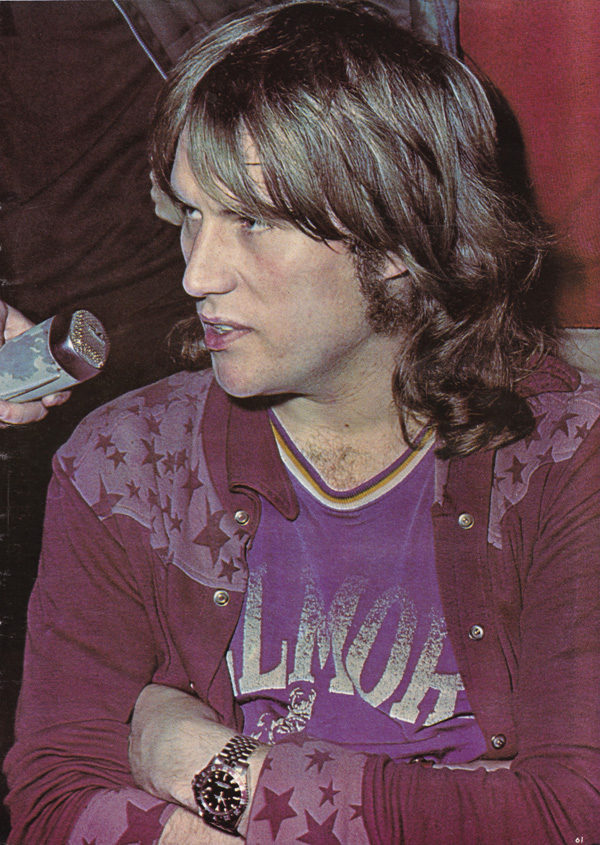
(Photo:
Jean-Yves Legras, 25 March 1972, Brussels)
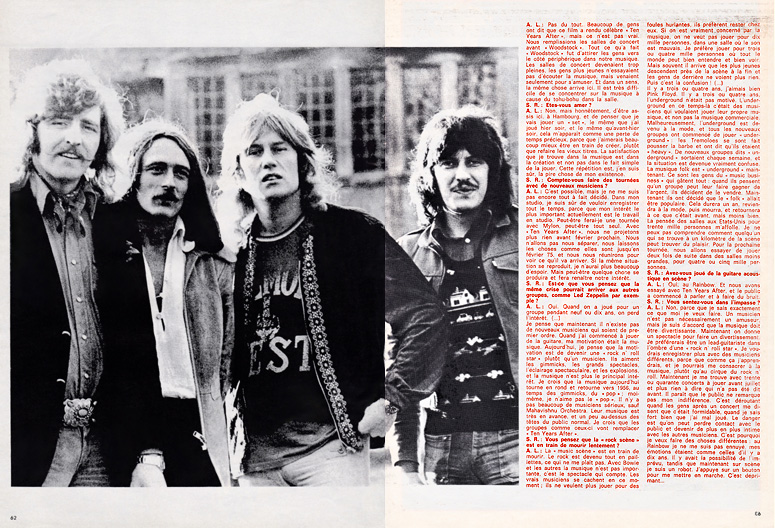
(Photo: Brian Cooke)


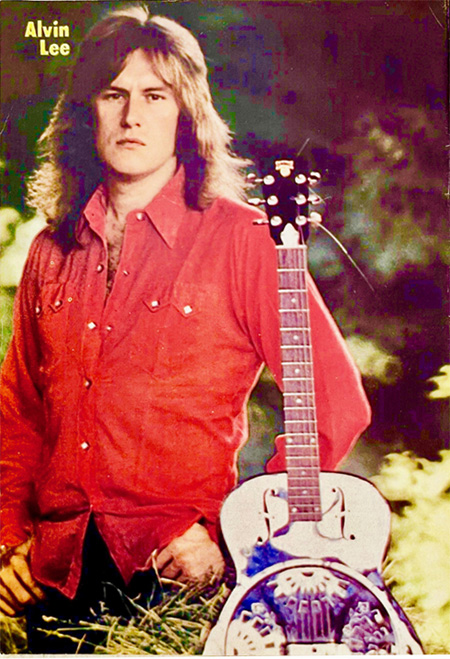
1974 Alvin Lee Poster -
"Tiffany" Music Magazine, Sweden
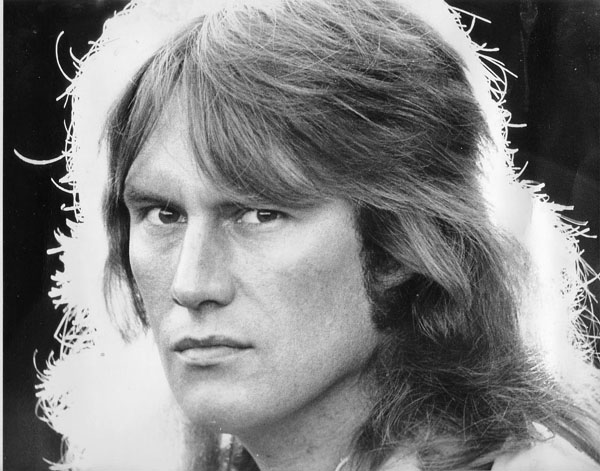
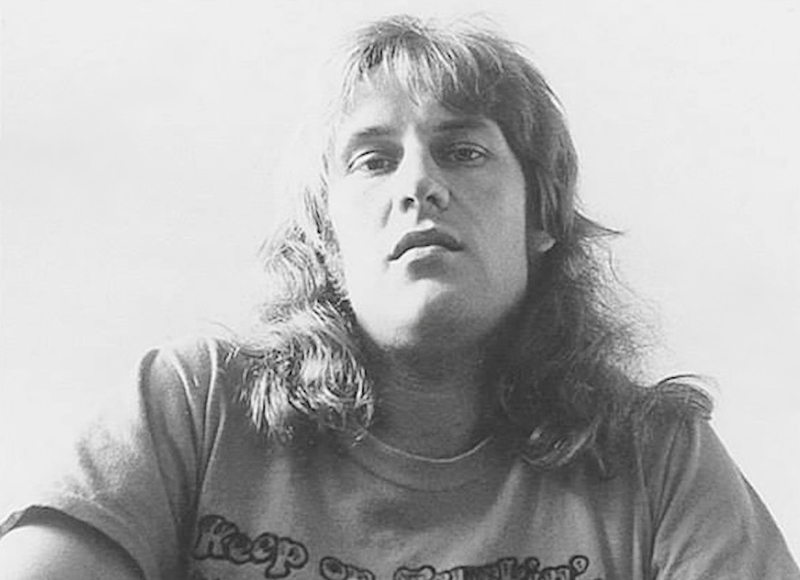
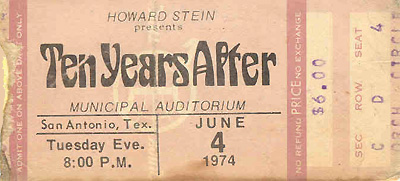
June 5, 1974 - Hofheinz
Pavilion, Houston
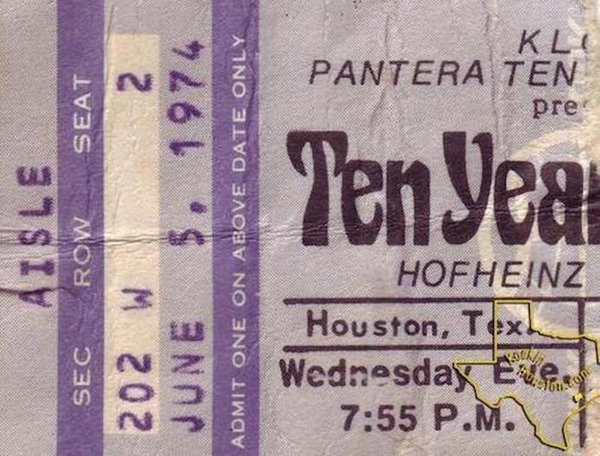
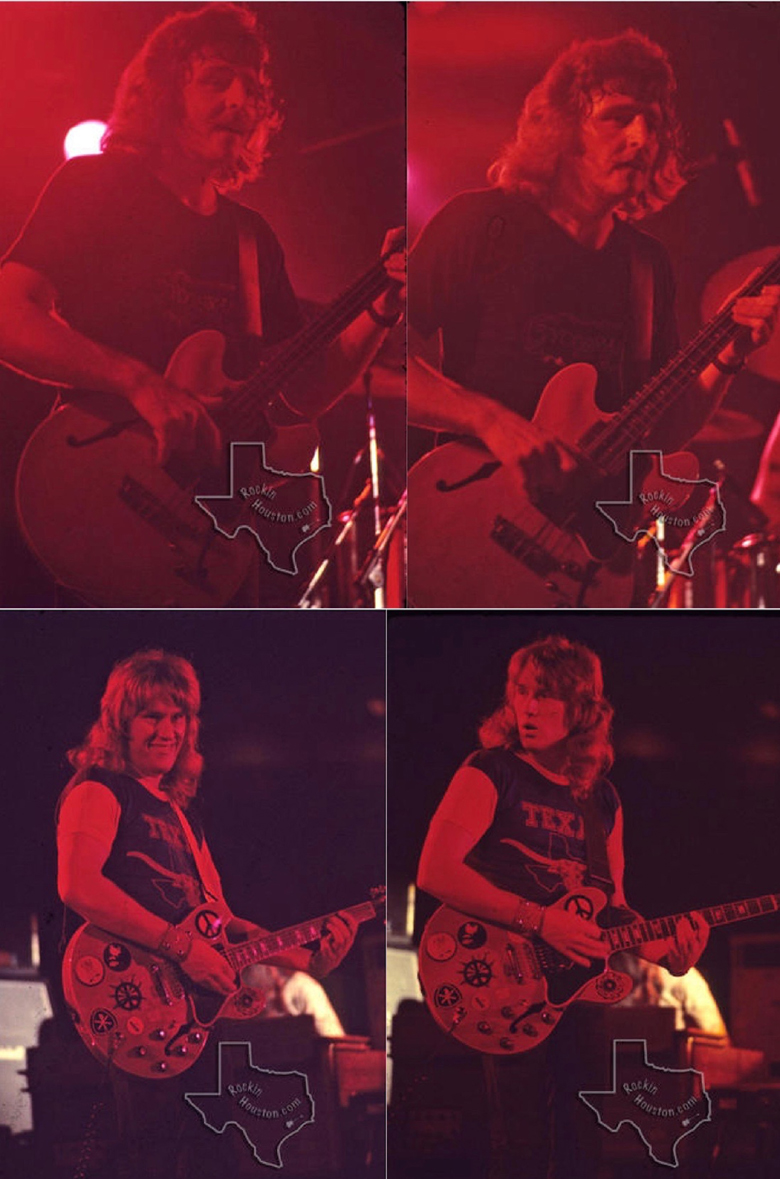
source: Rockin' Houston - Bruce
Kessler
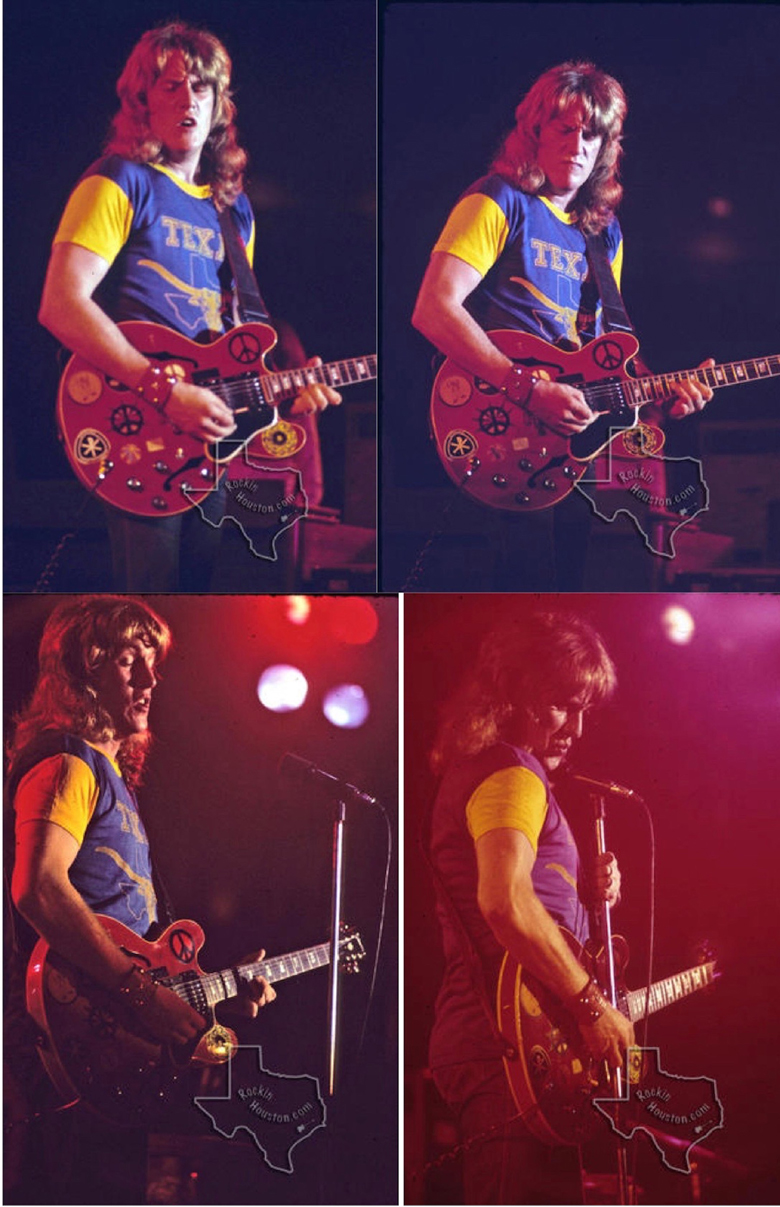

Alvin Lee - Photo by Charles Daughtry
Taken
at the Sam Houston Coloseum in Houston, Texas
More
excellent photography on his website
http://www.charlesdaughtry.com/
|
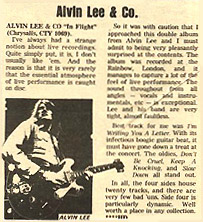
MS - June 7, 1974
Ten
Years After and Alvin Lee & Company - In Flight
Alvin
Lee has come a long way from being the energetic youth let
loose in Studio 2 at Decca’s Recording Studios
in West Hampstead. The album he was laying down then with
Chick, Leo Lyons and Ric Lee was titled
after
the group, “Ten Years After.” That
was in 1967. Ten Years After had spent part of it
constantly filling London’s Marquee club and had
achieved
a standing ovation from some 20,000 people at the 7th
National Jazz and Blues Festival, Windsor.
Seven
years on the rumours circulate of Lee leaving Ten Years
After to pursue fresh pastures with the Alvin Lee
and
Co. band.
London’s
Rainbow saw the initial appearance of Alvin Lee And Co.
band. Neil Hubbard, Alan Spenner, Tim
Hinkley,
Mel Collins, Ian Wallace and the Kokomo singers provided a
goodly diet of right funky music.
There
were voices busily shouting for TYA numbers. Lee heard,
smiled and waved and went his own way,
even
to an assortment of Little Richard and Elvis numbers, with
a “Don’t Be Cruel” of sufficient standard to make
most
Elvis freaks pay at least a little attention. Speculation
may rage; the whispers may become loud noises; Lee,
however waves gossip aside, “There’s no
intention
to split up TYA. As far as I know the others want to carry
and that accords with what I feel. It boils down
quite
simply to the fact of TYA not wishing, for a variety of
reasons, to have a crowded diary and Alvin having the
urge
to do more music and let loose in other musical directions.
Certainly TYA have not been far from his
consciousness
–at his 16
track studios based right where he lives in an old,
historic house in Berkshire,
“Positive
Vibrations” has emerged as TYA’s new album.
The
same place witnessed the warm-up to Alvin Lee And Co. Band
plus tracking for the enjoyable Chrysalis Released disc, “On the Road to
Freedom,” in which Gospel
background artist, Mylon LeFevre
joined Alvin.
Among
backing musicians
were well-known people like Jim Capaldi, Hari Georgeson,
Mick Fleetwood,
Ron
Wood and Stevie Winwood.
Lee
on his Rainbow gig; “The whole thing was an experiment.
We didn’t have that much time to rehearse.
If
it works I hope it will lead to more similar things. The
concert was recorded on our mobile truck, 16-track. No
it’s a test case to see if my company, Space Productions
can carry the recording side off. “I mean it will be
easy
to
get out on the road. We’ve done all the rehearsals.
Maybe we will do a couple of clubs. I mean we could
even
set off on a World tour. “It’s the involvement I enjoy.
I love getting musicians together and aiming
at
a goal.”
Lee
on TYA and his And Co. band project; “I think what
I’ve been up to recently prevents any break-up.
I’m
letting all my musical frustrations be channelled
elsewhere. Ten Years After, to me is a unit which
exists
quite happily within its scope. I don’t want to start
saying I want to include these and these numbers.
I
wouldn’t want to be after changing the format of TYA,
I’d rather do it outside that form and use TYA
as
a kind of communal music making group—which it is.
“I
don’t want to inflict my personal music tastes on that
set-up. Now I can develop all round in the way I feel.
I
think what I’ve been up to is making a sound quite a way
from TYA. For one thing it’s much quieter
with
not so much balls. For me there isn’t so much sweating
out on the guitar. This latest thing of mine is more
tasty, structured. Don’t forget the others have been up to some
things. “Leo has been producing UFO. Chick has
done
a solo album. Ric has been developing rock lyrics and a
few other things. Everyone has been getting
involved
with different scenes.
“I
mean you might say why doesn’t TYA, as it were, progress.
We’ve had this criticism from various quarters.
We
sat around and talked about it. I said our, original
concept was to play the music people wanted us to play.
We
can’t hit it off playing the music we wanted. I think
for instance some press criticism owes something to a difference between them and the
fans.
“The
fan comes because of the band, whereas sometimes the press
reporter arrives because it’s his job
and
he has a wider range of musical commitments and has
different expectations. “We did this Alley Palley gig
when
we came back from America. The place erupted and I thought
everyone was happy with it, you know, a
great gig. To me it confirmed
the decision not to change the music. TYA has
it’s own sound.
The
thing to do even if I were frustrated would be other
projects, that way I can enjoy playing with Ten Years
After.
I haven’t reached the stage of not enjoying playing with
the band. As to my remark about Ten Years as
a “Travelling Juke
Box” – Well it’s not a detrimental remark. It’s a
natural reaction from playing every
night
and
always being somewhere, new hotels, different flight plans. As
you say it’s like pressing a juke box button.
You
know for the next month you’re due on stage at 8 p.m.
You have to play whether you like it or not.
Lee
talking in general, “Woodstock was a great help to TYA,
through the film, record and being associated
with
an epic happening a whole load of new people latched on to
us. I don’t go for the big events. I prefer
to
do the kind of concert where there’s six or seven
thousand people. I think that’s the maximum for doing
a
really good concert. Over that you have problems, often
sound ones, with the size of the place.

“What
I think of our playing on the Woodstock album is that
there have been better versions of the number
but
for a live, recording well it was not to bad, the film
spot was really good. The film when it came out became
part of a great hype, of course, with “I Was There”
buttons and so on.
“By
taking our last number it established for many people that
we were a rock n’ roll band. I mean in TYA
we
do rock n’ roll but that’s not all of it! I thought at
the time if they had filmed , “I Can’t Keep From Cryin”
or one of the more structured things it might have been more
representative. “I think existing within the music
world
is about controlling what’s going on. So many people
don’t, there are so many things happening to
them
and they have no base and so groups break-up.
“My
own control over things has increased since making the
album “On The Way To Freedom” in the studios
here. I mean there’s a created production company and we did
the cover advertising and everything else.”
Future
Lee territory means the TYA album, a live-recorded album
from the Rainbow gig , and a likely
second
with Mylon, when the member of the famous Gospel family
comes over in June.
He
has an interesting comment on “So Sad,” the single
from “On The Road To Freedom.” “We played our
recording
to George Harrison. George looked at us and said he
assumed it was a demo! It wasn’t. We went away
and
did some things to it. That guy is a perfectionist. He
will take hours and hours laying things down. I have great
admiration
for him.”
Still
worried about a TYA split?
One
thing to remember, talk of this sort has been going on for
at least two years but Lee himself will not be leaving
the
scene whatever happens. As he says, “I can’t stay away from
music for longer than a week.”

|
|
Record Mirror – June 8, 1974

Alvin Lee is not
splitting with Ten Years After and that’s official, a
spokesman told Record Mirror this
week. “Rumours have been going on for some time that Alvin
was leaving Ten Years After, because of his work away from
the band with George Harrison and Mylon LeFevre,” the
spokesman said. “He’s been doing a lot of recording in his
own recording studio, but from all reports, everything
with Alvin and Ten Years After is okay. The band are
currently touring America and we’ve heard nothing to
indicate that Alvin wants to leave
Ten Years After”. |
Ten
Years After On The “National Scenes” 1974
June
7th – 9th Shrine Auditorium Los Angles,
California
June
11th Bakersfield, California
June
15th Santa Barbara, California
June 18th – 21st
Fresno, California

Ten Years
After:
On June
13, 1974 Ten Years After headlined at The Cow Palace.
The advertisement is from the
June 8, 1974 San Francisco newspaper for the upcoming concert on
June 13th.

14 June 1974 - Shrine Auditorium, Los
Angeles - Photo: Jeffrey Mayer
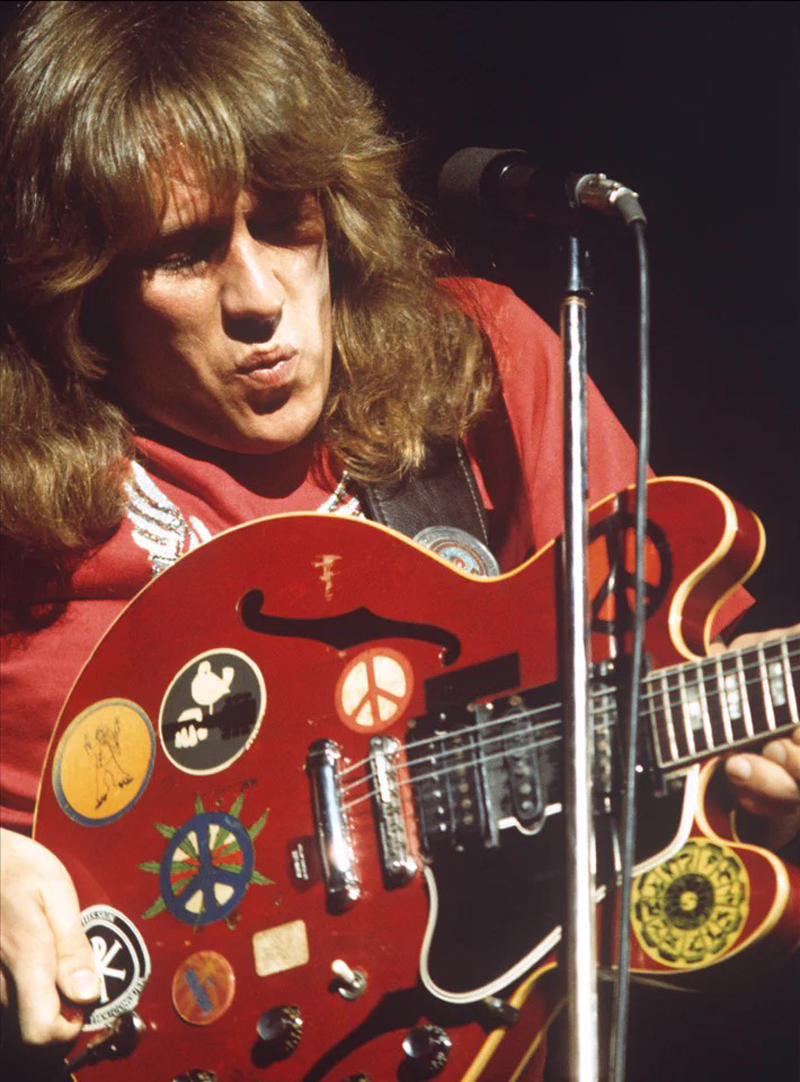
14 June 1974 - Shrine
Auditorium, Los Angeles - Photo: David Stratford
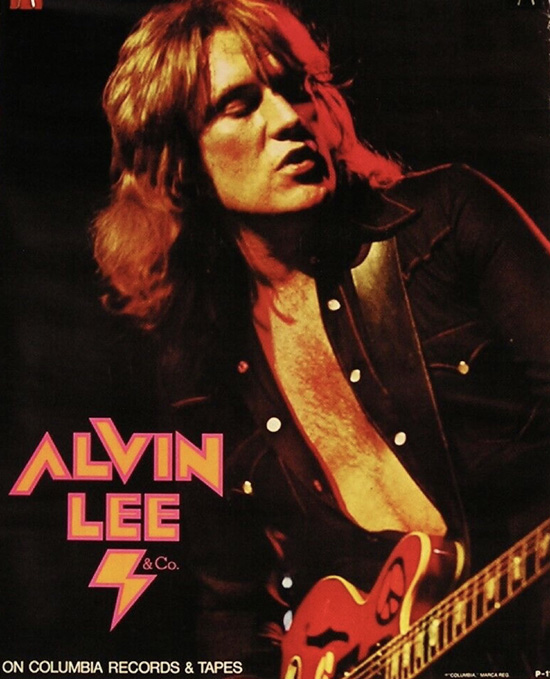
ALVIN LEE
"IN FLIGHT" WITH NEW BAND: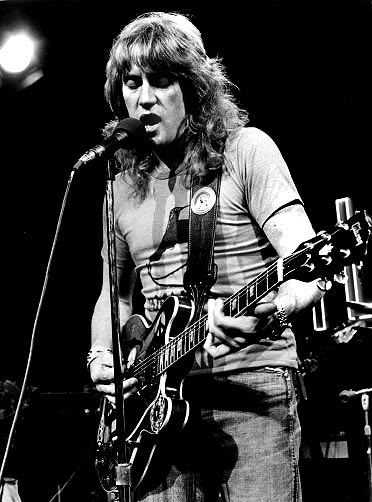
In an effort to
expand his musical horizons, Alvin Lee has suspended his
activties with Ten Years After and undertaken a tour with a new
band to perform material from his second solo album, "In
Flight". The grind of touring and the limitations put upon
Lee by "the violent thrashing and gritting of teeth"
in the Woodstock festival film had reached the point of
exhaustion. Ten Years' attempts to break into more lyrical areas
had failed, and Lee was spending his time between their gigs
recording songs totally atypical of the band's previous output.
Alvin ultimately
retired to his country retreat to consider his next move. One
night he was visiting at George Harrison's home, and discussed
his dilemma with Harrison advisor Terry Donan. Donan insisted
that most musicians don't possess enough independence to follow
a direction of their own choosing.
"Well"
said Lee "I can choose to do whatever I want, whenever I
want to do it." Donan called his bluff: "If you're as
independent as you say you are," he taunted, "then why
don't you put on your own solo concert at the Rainbow Theater in
London?"
The rest as we know
is history and thanks to Donan's idea Alvin pulled off one of
the greatest concerts of all time.
1975 CBS Inc. Circus
Magazine
|

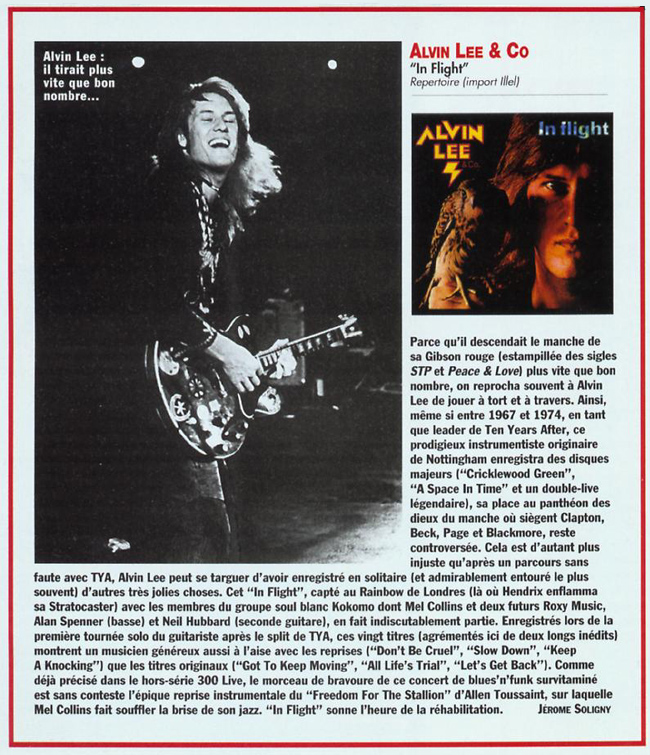
|

Melody
Maker - June 22, 1974
Ten
Years After - “Positive Vibrations” (Chrysalis).
TYA
Boogie On
No
messing about, straight into the funky riff and
blues-stained vocals on “Nowhere To Run.”
You
might say “I’ve heard all this before.” But that is
a definition of popular art. It’s very familiarity is part
of the reason for the survival of a brand of music that
some thought exhausted by 1969. But here they are,
one
of the oldest bands in captivity, still going strong . And
after a few bars, your head starts to nod and
feet
do wiggle in a kind of Pavlov’s dog reaction. And tunes
like “Positive Vibrations” are quite pleasant,
with
Alvin singing very nicely and playing unusually laid-back
guitar for a TYA gig.
Chick
Churchill’s piano rings merrily and Chick elsewhere adds
electric piano,
clavinet and a spot of
Moog.
And as we progress further, why “Stone Me,” has an
extremely effective boogie beat with
a
trance of harmonica from Alvin that takes us back to the
steamy blues clubs of yesteryear.
Ric
Lee swings’dem drums and it’s a lot of fun. TYA vocals
in general seem to have taken a turn for the better,
with
less of the old anguished yelling, and more tuneful
harmonizing as detected on “Without You.” But
just
in case old TYA fans are impatient with all this trend
towards sweet nothings, “Going Back To
Birmingham”
has Alvin cutting a rug and slashing the carpets.
“It’s Getting Harder,” has Churchill getting
a
big band sound from his keyboards, and lots of wah-wah
chucking away.
 Note
the excellent production here, which is maintained
throughout, and helps make this one of the best,
if
least publicised of their albums.
The
rest of the material continues through some sprightly rock
n’ roll. “You’re
Driving Me Crazy,” a neatly arranged “Look Into My
Life,” and “Look Me Straight Into The Eyes,”
and
a cheerful farewell “I Wanted To Boogie.” Note
the excellent production here, which is maintained
throughout, and helps make this one of the best,
if
least publicised of their albums.
The
rest of the material continues through some sprightly rock
n’ roll. “You’re
Driving Me Crazy,” a neatly arranged “Look Into My
Life,” and “Look Me Straight Into The Eyes,”
and
a cheerful farewell “I Wanted To Boogie.”
Plain
home cooking for the average enthusiast.
By Chris Welch
|
Ten
Years After – Positive Vibrations Review – 1974
It
is claimed that Ten Years After have confounded
their critics just by releasing this album and
scotching the growing rumours about their impending
split. If that was the aim in producing this work,
then they have succeeded, but no other target has
been reached. This is a collection of ten instantly
forgettable tracks that boogie very smoothly, but
offer nothing of originality or interest. I’m
afraid that Alvin Lee is still playing the licks
that have sustained him in sybaritic ease the past
few years and there’s a general feeling of
listlessness.
“It’s
Getting Harder” at the beginning of side two,
almost gets into the James Brown groove and it’s
probably the best track on the album. The record was
made at Lee’s back garden “Space Studios” and
the recording sound is no better than average.
Review
by R.H.
|
June 1974 - EXTRA
Magazine, No. 43, France
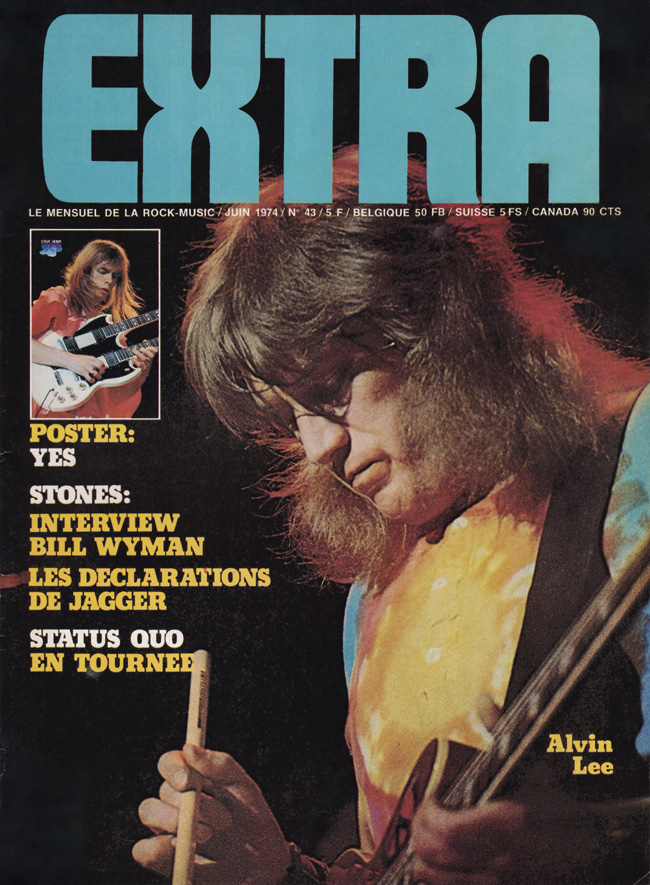
Photo: Ilpo Musto

Photos
above and below: Erik Machielsen

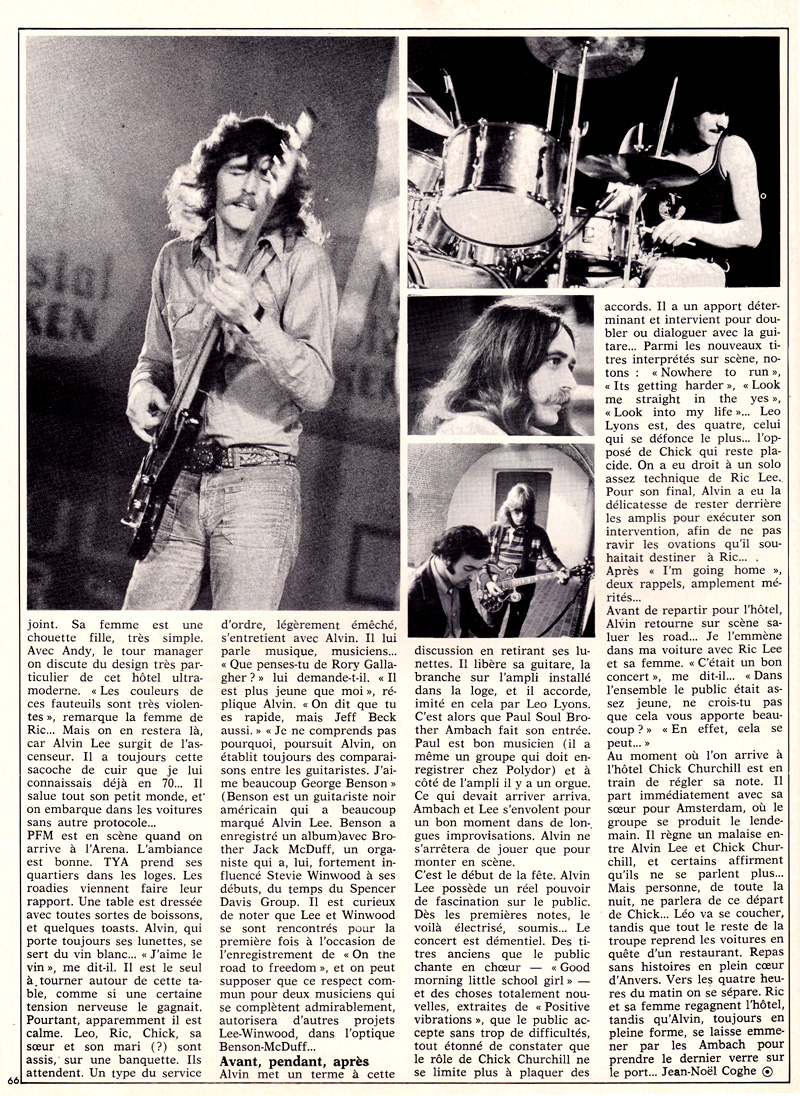
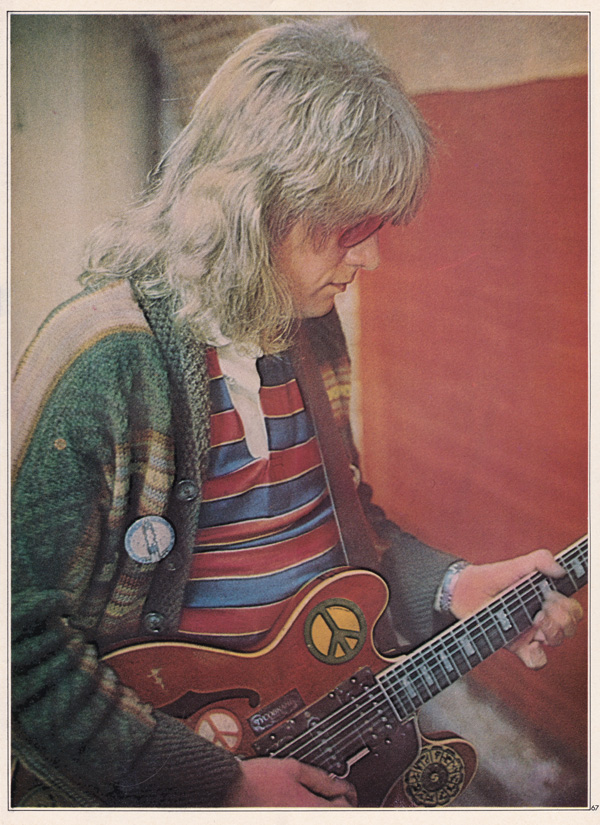
Photo: Erik
Machielsen

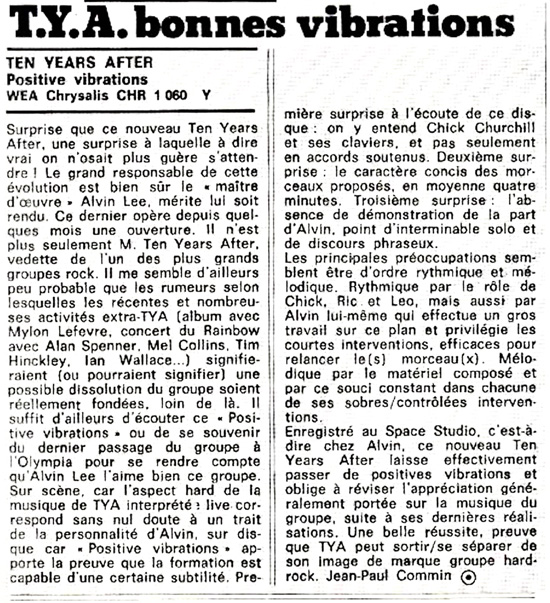
EXTRA Magazine,
No. 43 - Review "Positive Vibrations"
|
Positive Vibrations 1974
Positive
Vibrations, or is this just word play on the Beach
Boys “Good Vibrations” ?
I could see
how some would say that Ten Years After had run out of
steam at this point.
This being their last studio album and all. As certain
parts sound like the group is just coasting, but that
is the view of the jaded music critics. The less
cynical music fan will most likely find it acceptable,
enjoyable and worth the money spent. Especially, if
they can find it in the thrift store, for fifty cents. |
|

Dutch
advertisement for TYA's "Positive Vibrations" 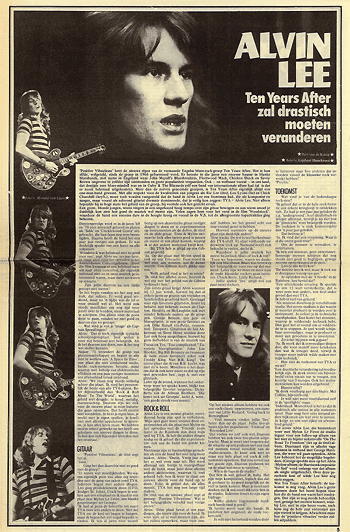
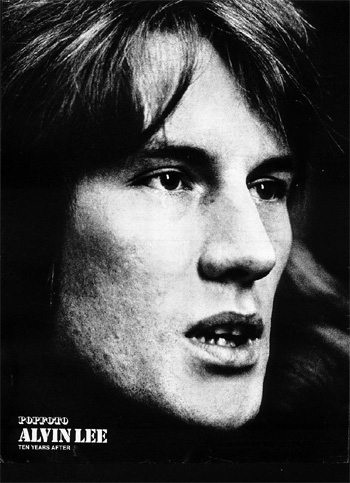

Leo Lyons - 1974 Amsterdam,
Netherlands
Photographer: Gijsbert
Hanekroot
Website:
https://gijsberthanekroot.com/
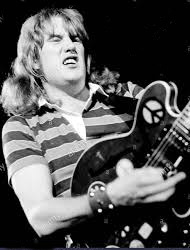 


|
PLAYING THE LEE'D GUITAR!
From Music World & Beat
Instrumental Magazine
From June of 1974 Issue
 |
Probably the only British musician
who looks on his 19th States tour as a rest is Ten Years
After's Alvin Lee - and that's not just a line. In March he
played London's Rainbow with friends and reckons that to start
with it was the most nerve-racking gig he'd had since he first
went on stage.
At the moment he's probably on the boards somewhere in the
States ripping notes from the weathered 335, his travelling
companion for the past eight years - back in his established
place at the front of Ten Years After, and enjoying his rest.
But back to his Reading country house for a minute, and
shortly before departure. Will this really be a rest?
"Ten Years After works very smoothly and it'll be like a
holiday, playing every night. I'm really looking forward to it,
and it'll be a rest more than anything."
Alvin Lee's Rainbow concert in March was recorded for a live
album which he expects will be released in August. Like his
album with guitar picker Mylon Le Fevre, it's evidence of his
expanding musical interests, but he doesn't intend to let them
conflict with Ten Years After.
They've recently been rehearsing material from the new
Positive Vibrations album to incorporate into the act.
"I was thinking of augmenting the band," said Alvin,
"and using other musicians , but they weren't very keen
on that. I can see their point though - that Ten Years After
is Ten Years After, and shouldn't expand out of its depth. Add
a fifteen piece orchestra and it wouldn't be Ten Years After.
|
BOOGIE
"Where Ten Years After scores to
my mind is with the choogling boogie thing, it gets going and
can't be stopped, and that's the bands essence. The influences
of what Chick and I have been doing are coming in subtly. Ten
Years After's music is very much high energy, a conglomeration
of the four of us. For the last album we had about twenty
numbers and a lot of them were like new things Chick and I
have been doing. But we had to agree. Unless Leo and Ric and
everybody have lines they can work with it's not the music of
the band. It's nice to think of the band keeping an identity."
Although he's keen to keep Ten Years After touring, do his
other interest mean that the band is now a finance vehicle?
"It has been said so before and, in fact, the situation
is like that, unfortunately - but I haven't let enter into my
decisions. If I was not to work for Ten Years After, I could
do the band's commitments on my own and get more money. But I
make money a side issue, and don't want it to be my motivation
. I find that if you take care of the music the rest takes
care of itself." The just reward I wondered? "No,
not always. I don't do anything because the money's better -
it always kicks back if you do that," he said.
He admitted to not making any money out of the Rainbow
concert, but stressed it was for fun more than anything.
"It started when Ian Wallace, Tim Hinckley, Mel Collins,
Boz Burrell and myself started a sort of Muscle Shoals rhythm
section called The Gits. It got so far we started recording
and getting different singers down." (Alvin has a
fair-sized 16 - track studio in a barn near the house.) "Then
- this was about a month before the gig, Terry Doran heard us
and said why don't you do a concert? I had one of those
flashes and just said yes. We booked the Rainbow the next day,
had organisational meetings, and got into it like a project."
INSANE
The band he finally got together
consisted of himself, Mel Collins, Tim Hinckley, Alan Spenner,
Neil Hubbard, and singers from new band Kokomo. Rehearsals
began at the home studio ten days before the gig.
"It was a bit insane really. This place was really buzzin".
We got up at nine one morning for a slit-eyed photo session,
and then went into the studio for about twenty three hours. We
got fifteen numbers arranged and rehearsed that time, and felt
very confident with eight days to go. But the next day was a
washout, and nothing worked. With the gig four days away we
found we'd got fifty five minutes of material - for a two hour
show! But because of the Press saying it wasn't just a fun gig,
it was me trying to prove that I could go solo, it all became
important and heavy.
"When the singers came down we ran through the whole
thing once and found we had an hour and ten minutes. We then
ran through loads of stuff that everybody would know, like
Mystery Train and Jailhouse Rock, and we got five numbers to
slip in. They were just sort of banged off," he laughed,
"we thought we'd worry about ending off on the night."
The band got to the Rainbow during
the afternoon and although they hoped for a complete
run-through and a meal, there was never time. "Suddenly
it was all on us…and I was really nervous. More nervous than
I've been since I first went on stage. I was getting these
very weird flashes of thinking I was just on the road doing a
tour…and then thinking about the different numbers, and the
choruses, and who takes the first solo and the words. The
words were incredible. I couldn't remember half the words. I
would be about to kick off and then I'd see this totally
different band in the environment where I'd seen Ten Years
After for the past six years. Very weird, but great in its own
way."
Alvin has now had a good chance to
listen to the tapes since the gig and reckons that everyone
felt a bit insecure for the first half an hour. After that it
all got a lot more positive - "but looking back it seems
silly doing all that work for one gig. It would have got
really tight in two or three nights."
Alvin's new albums are coming out through his Space
Productions production company, and together with his studio,
this means that he can now record and release albums by other
artists. But the time problem and the fact they're released
through Chrysalis means he can't just record and release who
he likes and when he likes: "I'd like to, and there are a
couple of things, that are very loose at the moment, which
might come together in the distant future. But I don't want to
approach somebody and say I'll do a deal with you. I'd prefer
them to approach me - but in fact they don't like to do that
either, so it's something of a stalemate."
CHANGE
Alvin mentioned that two years ago he
didn't believe in jamming, and working and playing outside the
band. Now he's involved with a confusing number of musical
directions - when did he first begin to change?
"The stopping point came when I felt like I'd written
every song I could think of with Ten Years After, and played
every solo…all I was doing was pinching bits from this and
that and putting them together differently, and it was
starting to get repetitive. That's when these different forms,
styles and attitudes started to develop as a recorded thing
rather than a hobby.
"I started finger - picking guitar, but never as
seriously as working with Ten Years After , and that's where
Mylon came in. We started playing a lot of country and Chet
Atkins things.
That was a medium for me to play those tasty Fender Telecaster
- type licks, rather than the Gibson screamers."
But for the moment anyway, it's back to those Gibson screamers
and Goin´ Home. He's had the battered, sticker - covered 335
for close on eight years, and with a Strat pick-up wired in
reckons it gives him all the sounds he needs with Ten Years
After. Although he readily admits to there being faster
guitarists, Alvin too is fast when he wants to be. Two players
he loves to listen to are Chet Atkins and George Benson.
"As far as speed is concerned George Benson is amazing.
When he plays a run it just goes whoosh, right up the neck.
Now that's speed."


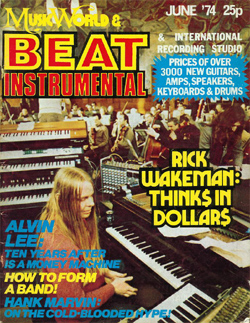
|
| New
Musical Express - June 29, 1974

Article by Barbara
Charone – Chicago
Alvin Lee does a
nifty sidestep to Stevie Wonder’s “Living In The City” in
his posh hotel suite towering high above Chicago. But don’t
be misled, because today our lightning fast guitar whiz is
bored. Boredom has been one of the Ten Years After headman’s
big problems of late…a severe case of career frustration and
“where is it all leading to?” “If you’re going to ask about
Ten Years After breaking up,” the road manager advises me,
before I start, “forget it. He ain’t talking”. Alvin Lee and
Ten Years After, incidentally, were in Chicago for a gig.
A sold-out gig. So
despite all the adverse talk, Ten Years After are still very
popular here.
“You can’t worry
about what people are going to say or you’ll never do
anything , “Alvin opens defensively. It’s like my London
Rainbow solo concert. Everybody said, “You can’t do that,
people will say Ten Years After are breaking up,” But I did
it, and everybody said we were breaking up. And sure enough
we didn’t. “I told the band I guaranteed them three months a
year working with Ten Years After, covering an album and a
world tour, which is all we’ve ever done, really. And that’s
the way it is. “What the band are worried about, naturally,
is whether I’ll have more success on my own, than with them.
“In the beginning it was very hard, but the whole reason I
did solo projects, like the Rainbow was because I was bored
and frustrated. It got to a stage where” and he pauses,
demonstrating pent up frustration and “well, I’ll tell you
it got pretty bad. But now, the band understands. Besides….”
He smiles. “I don’t want to be responsible for telling three
guys, that they’re out of work, or for telling 300,000
people they can’t see the band anymore. I hate
reasonability”.
The impetus behind
Lee’s solo projects of late, has been to rejuvenate his
career and counter the circus-like life of a touring rock
and roll band, which is enough to drive anyone crazy.
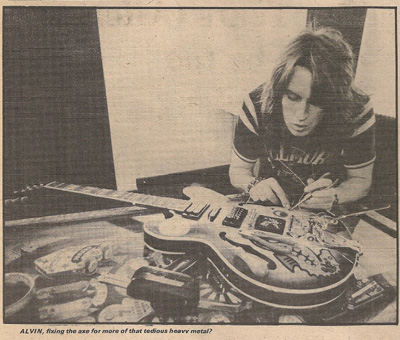
He says reflectively :”When I first became a musician, it
was to escape from a nine-to-five job. And when I went back
home a few months ago, I walked down the same road I used to
walk down when I was sixteen and used to work in a factory.
And I knew I couldn’t have taken thirty years of it…working
in a factory”. So Alvin got out of the factory all right,
then found himself trapped in the confines of the rock biz.
Going on stage like a juke-box, pumping out old material.
“When I made the album with Mylon, I got more involved with
the music than I had done for a long time. And it reminded
me of when of when I first started making music. “You know,
you start in the beginning with a little local band three
nights a week, and it’s a groove. Then the band takes off
nationally, and internationally, and then, that’s how it’s
been with Ten Years After. There are two or three years when
no one knows what’s happening. You don’t know what it all
means. And through that period we just worked like donkeys”. Alvin laughs: ”Well, if anyone wanted to book us, we were there, and we kind of burned ourselves out. Obviously, the full scale rock `n´ roll circus days are over for Alvin Lee. Although just five weeks a year touring can be fun. He expresses his doubts about the whole thing: “If you want to do an American tour, and play loud rock `n´ roll, I suppose that’s fine. But people don’t really want to hear sophisticated music. I even had my doubts about using acoustics at the Rainbow, because I mean, the majority of kids take downers, and come to gigs to scream and boogie. “It’s quite silly playing a song when there’s dodging and shouting going on in front of the stage. That’s not what I’m here for”. There’s no doubt that Alvin is thinking particularly of America in this respect. You see, over here, they squeeze thousands of kids into over-grown garages. And after too many years of touring, these
barn-yard arenas, he’s decided to opt for smaller shows in a Rainbow like concert atmosphere.
“I want to do some dates with Mylon, but I’d like to sort myself out first. I’m trying to get the kind of situation where I can do what I want, without all these problems. To me it’s simple:
“I wake up in the morning and if I want to do something I should be able to. It’s like that song “Positive Vibrations” and if I want to do something, I should be able to just do it”.
Still, Alvin Lee seems happier now and perhaps more musically content than he’s been since his pre-Woodstock days, when Ten Years After were on the brink of super-stardom. “before the film, we had a good-sized audience who came for the jazz and blues and the quieter stuff. They were the moustached kids, ya know what I mean? It was great. But after Woodstock, we became just another rock `n´ roll band”. Well at Chicago, 12,000 kids were waiting for Alvin Lee and Ten Years After to come on stage, and play their guts out. And not one of those kids thought that Ten Years After were just another rock `n´ roll band.
Article by Barbara Charone
|

|